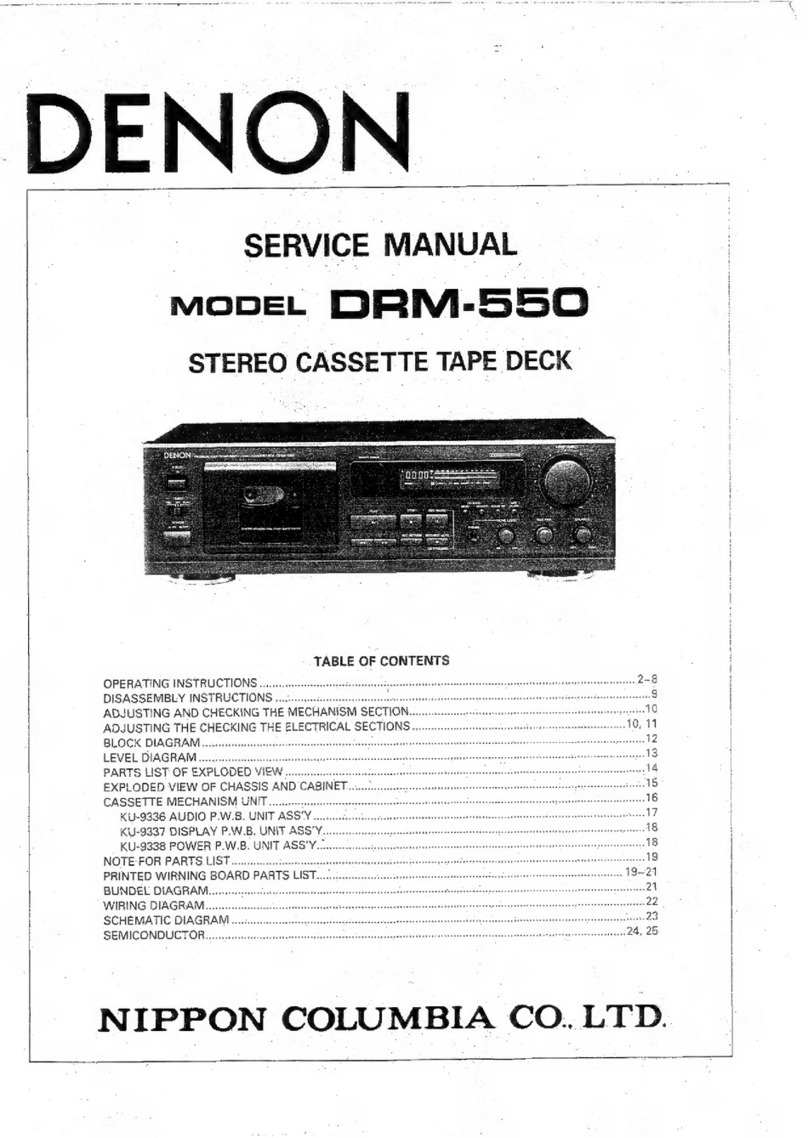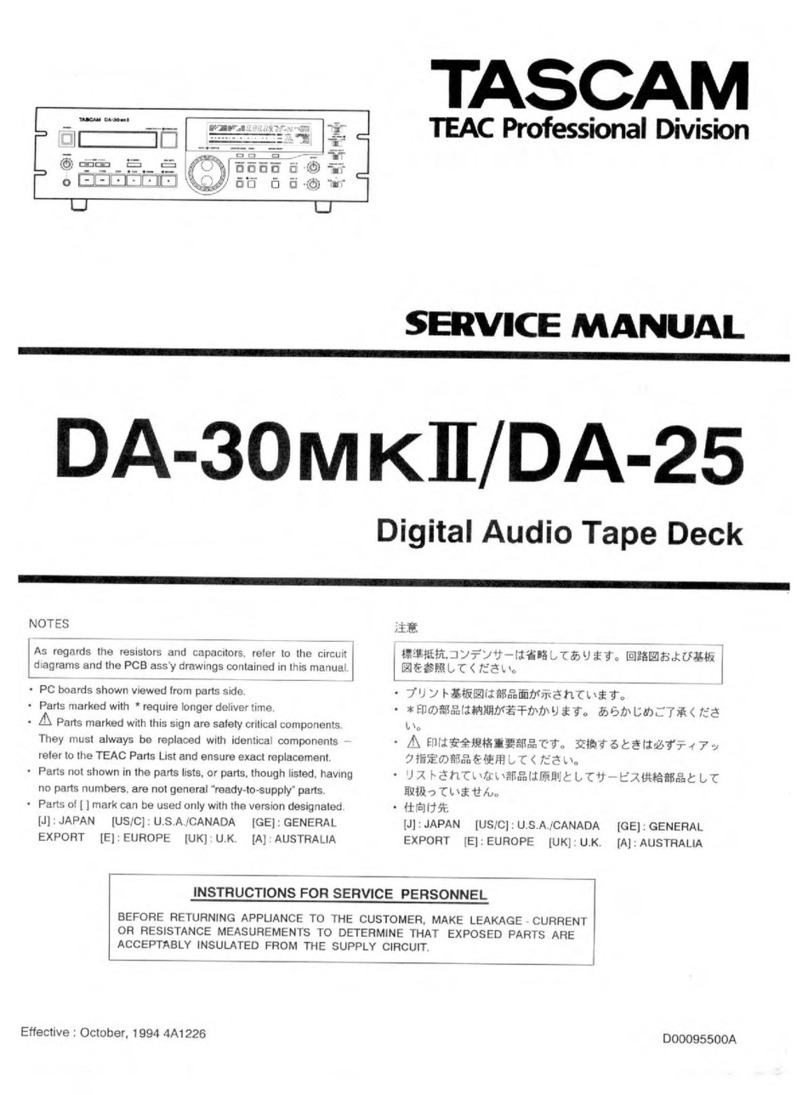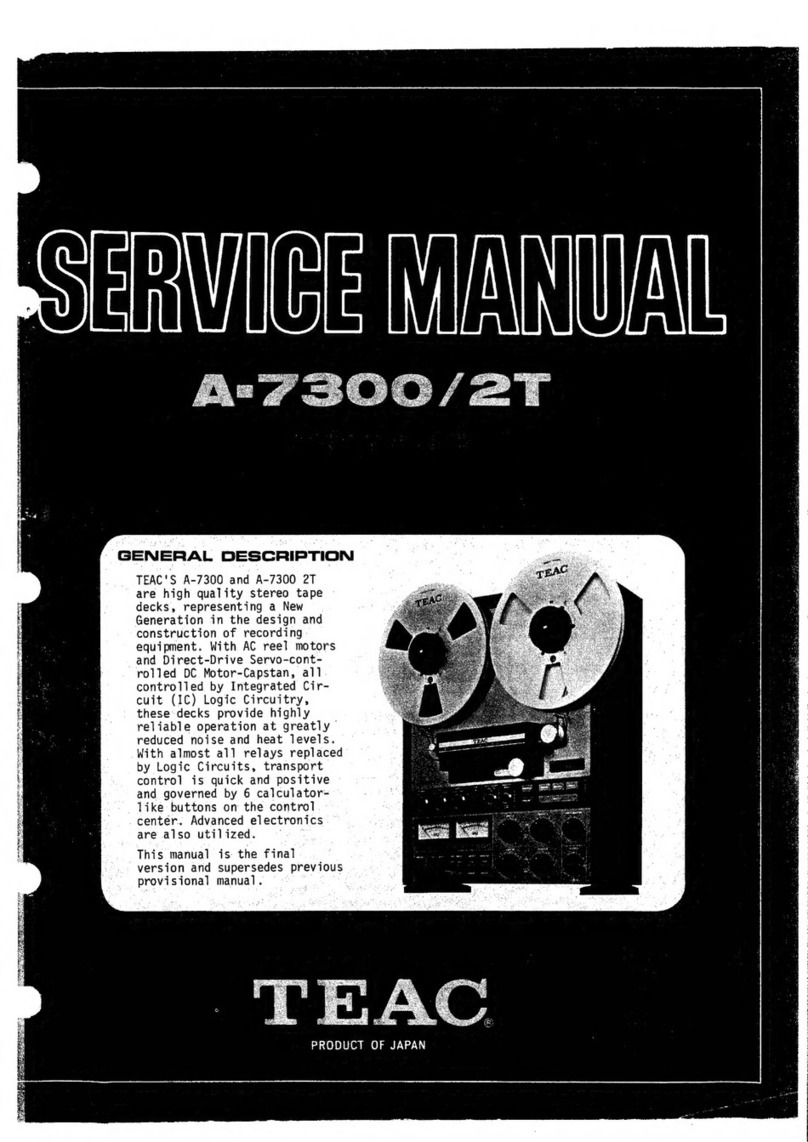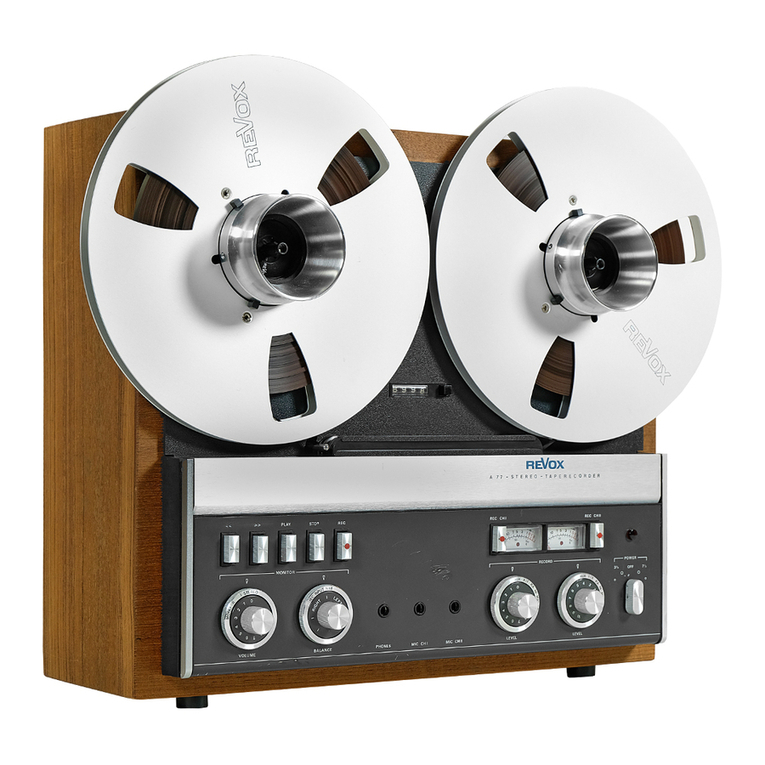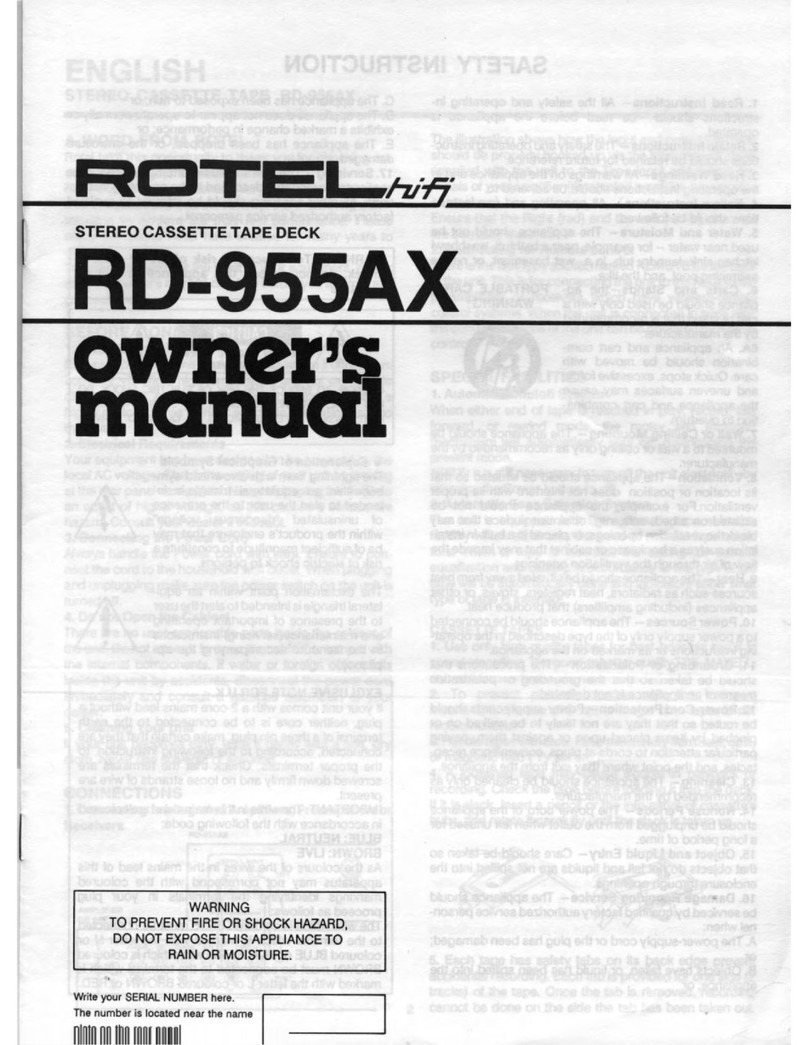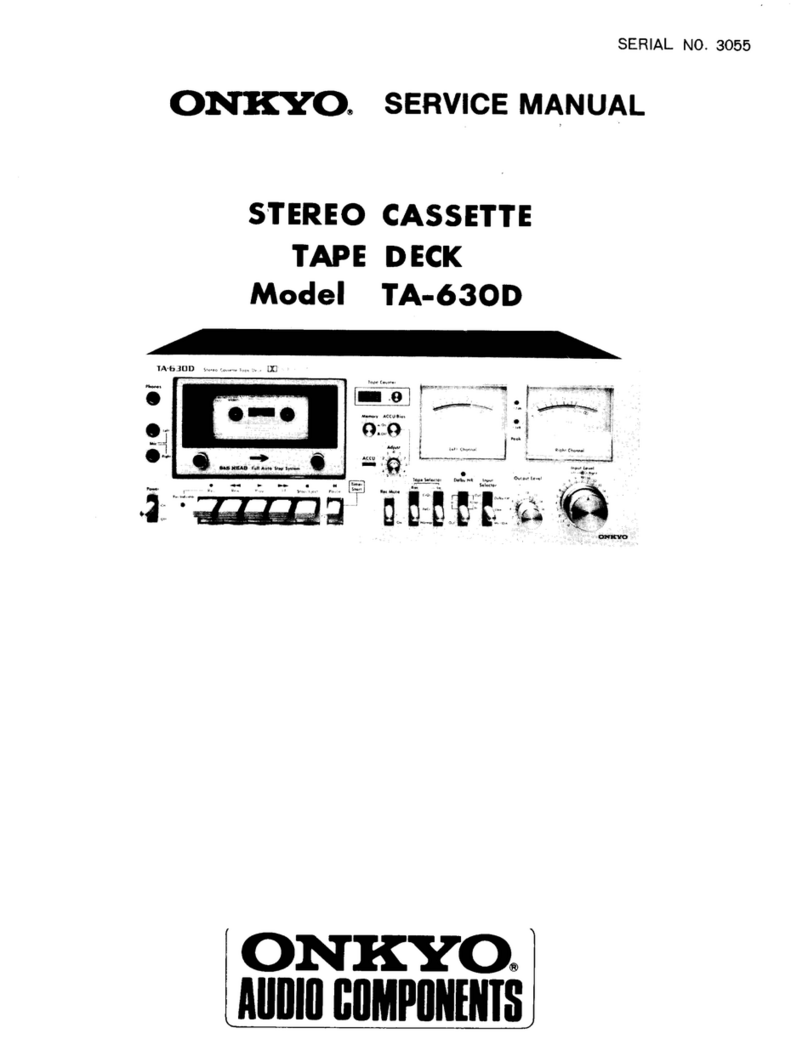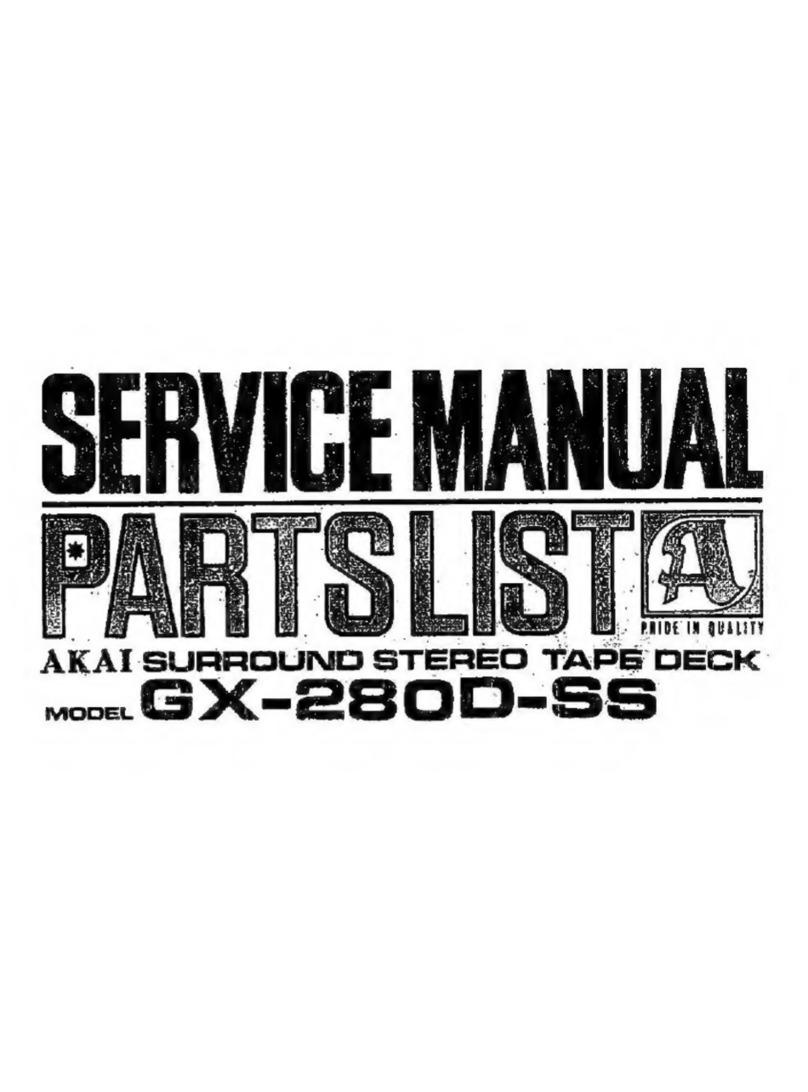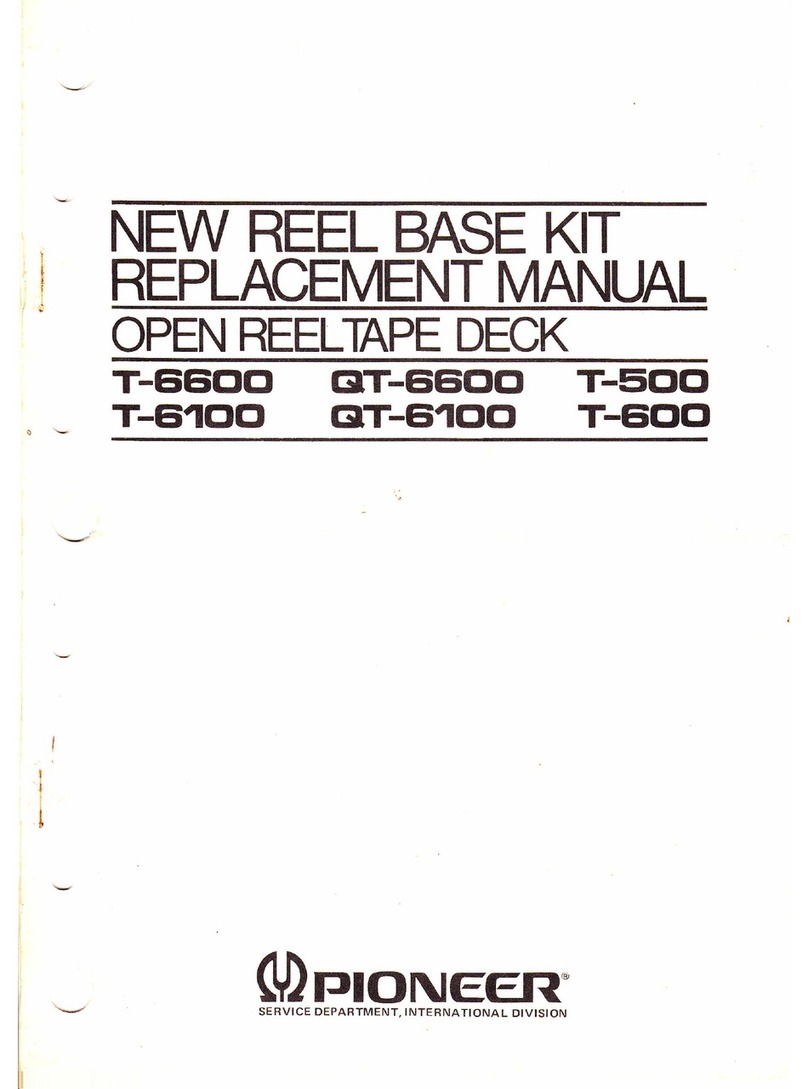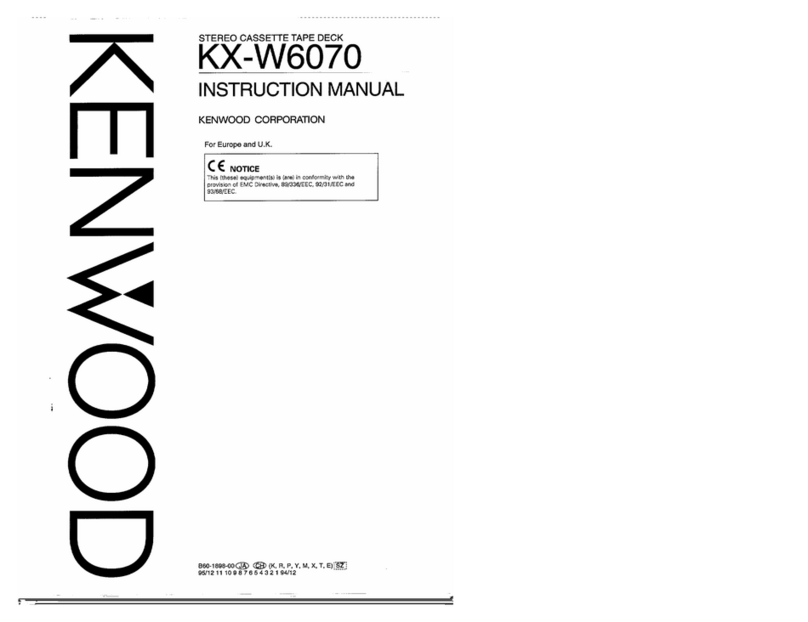Denon DRM-595 User manual

STEREO CASSETTE TAPE DECK
DRM-595
OPERATING INSTRUCTIONS
BEDIENUNGSANLEITUNG
MODE D’EMPLOI
ISTRUZIONI PER L’USO
INSTRUCCIONES DE OPERACION
GEBRUIKSAANWIJZING
BRUKSANVISNING
INSTRUÇÕES DE OPERAÇÃO
PLAY 2 STOP 3 REC PAUSE
B
REMOTE SENSOR
REC/REC MUTE
PHONES
INPUT LEVEL
EJECT
¢ON £STANDBY
B OFF C
REC OFF PLAY
TIMER
PHONE LEVEL
MIN MAX LEFT RIGHT
BIAS FINE
DIRECTION
CD SYNCHRO REC
0
DOLBY NR REV. MODE
BALANCE
5
6
7
8
9
10
1
2
3
4
DRM-595
CASSETTE TAPE DECK
+
RESET
COUNTER
MEMORY
MPX
AUTO REVERSE
FOR ENGLISH READERS PAGE 2 ~ 13
FÜR DEUTSCHE LESER SEITE 2 ~ 4, 14 ~ 22
POUR LES LECTEURS FRANCAIS PAGE 2 ~ 4, 23 ~ 31
PER IL LETTORE ITALIANO PAGINA 2 ~ 4, 32 ~ 39
PARA LECTORES DE ESPAÑOL PAGINA 2 ~ 4, 32, 40 ~ 46
VOOR NEDERLANDSTALIGE LEZERS PAGINA 2 ~ 4, 32, 47 ~ 53
FÖR SVENSKA LÄSARE SIDA 2 ~ 4, 32, 54 ~ 60
PARA LEITORES PORTUGUESES PÁGINA 2 ~ 4, 32, 61 ~ 67

2
IMPORTANT TO SAFETY
WARNING:
TO PREVENT FIRE OR SHOCK HAZARD, DO NOT EXPOSE THIS
APPLIANCE TO RAIN OR MOISTURE.
•DECLARATION OF CONFORMITY
We declare under our sole responsibility that this product, to
which this declaration relates, is in conformity with the
following standards:
EN60065, EN55013, EN55020, EN61000-3-2 and EN61000-3-3.
Following the provisions of 73/23/EEC, 89/336/EEC and
93/68/EEC Directive.
•ÜBEREINSTIMMUNGSERKLÄRUNG
Wir erklären unter unserer Verantwortung, daß dieses Produkt,
auf das sich diese Erklärung bezieht, den folgenden Standards
entspricht:
EN60065, EN55013, EN55020, EN61000-3-2 und EN61000-3-3.
Entspricht den Verordnungen der Direktive 73/23/EEC,
89/336/EEC und 93/68/EEC.
•DECLARATION DE CONFORMITE
Nous déclarons sous notre seule responsabilité que l’appareil,
auquel se réfère cette déclaration, est conforme aux standards
suivants:
EN60065, EN55013, EN55020, EN61000-3-2 et EN61000-3-3.
D’après les dispositions de la Directive 73/23/EEC, 89/336/EEC
et 93/68/EEC.
•DICHIARAZIONE DI CONFORMITÀ
Dichiariamo con piena responsabilità che questo prodotto, al
quale la nostra dichiarazione si riferisce, è conforme alle
seguenti normative:
EN60065, EN55013, EN55020, EN61000-3-2 e EN61000-3-3.
In conformità con le condizioni delle direttive 73/23/EEC,
89/336/EEC e 93/68/EEC.
•DECLARACIÓN DE CONFORMIDAD
Declaramos bajo nuestra exclusiva responsabilidad que este
producto al que hace referencia esta declaración, está
conforme con los siguientes estándares:
EN60065, EN55013, EN55020, EN61000-3-2 y EN61000-3-3.
Siguiendo las provisiones de las Directivas 73/23/EEC,
89/336/EEC y 93/68/EEC.
•EENVORMIGHEIDSVERKLARING
Wij verklaren uitsluitend op onze verantwoordelijkheid dat dit
produkt, waarop deze verklaring betrekking heeft, in
overeenstemming is met de volgende normen:
EN60065, EN55013, EN55020, EN61000-3-2 en EN61000-3-3.
Volgens de bepalingen van de Richtlijnen 73/23/EEC,
89/336/EEC en 93/68/EEC.
•ÖVERENSSTÄMMELSESINTYG
Härmed intygas helt på eget ansvar att denna produkt, vilken
detta intyg avser, uppfyller följande standarder:
EN60065, EN55013, EN55020, EN61000-3-2 och EN61000-3-3.
Enligt stadgarna i direktiv 73/23/EEC, 89/336/EEC och
93/68/EEC.
•DECLARAÇÃO DE CONFORMIDADE
Declaramos sob nossa exclusiva responsabilidade que este
produto, ao qual esta declaração corresponde, está em
conformidade com as seguintes normas:
EN60065, EN55013, EN55020, EN61000-3-2 e EN61000-3-3.
De acordo com o estabelecido nas Directivas 73/23/EEC,
89/336/EEC e 93/68/EEC.
Please, record and retain the Model name and serial number of your set shown
on the rating label.
Model No. DRM-595 Serial No.
CAUTION:
• The ventilation should not be impeded by covering the
ventilation openings with items, such as newspapers, table-
cloths, curtains, etc.
• No naked flame sources, such as lighted candles, should be
placed on the apparatus.
• Please be care the environmental aspects of battery
disposal.
• The apparatus shall not be exposed to dripping or splashing
for use.
• No objects filled with liquids, such as vases, shall be placed
on the apparatus.
CAUTION
RISK OF ELECTRIC SHOCK
DO NOT OPEN
CAUTION: TO REDUCE THE RISK OF ELECTRIC
SHOCK, DO NOT REMOVE COVER (OR
BACK). NO USER-SERVICEABLE PARTS
INSIDE. REFER SERVICING TO QUALIFIED
SERVICE PERSONNEL.
The lightning flash with arrowhead symbol, within an
equilateral triangle, is intended to alert the user to
the presence of uninsulated “dangerous voltage”
within the product’s enclosure that may be of
sufficient magnitude to constitute a risk of electric
shock to persons.
The exclamation point within an equilateral triangle is
intended to alert the user to the presence of
important operating and maintenance (servicing)
instructions in the literature accompanying the
appliance.
ENGLISHDEUTSCHFRANCAISITALIANOESPAÑOLNEDERLANDSSVENSKAPORTUGUÊS

3
FRONT PANEL
FRONTPLATTE
PANNEAU AVANT
PANNELLO ANTERIORE
PANEL FRONTAL
VOORPANEEL
FRAMSIDA
PAINEL FRONTAL
B
REMOTE SENSOR
PHONES
INPUT LEVEL
EJECT
¢ON £STANDBY
B OFF C
REC OFF PLAY
TIMER
PHONE LEVEL
MIN MAX LEFT RIGHT
BIAS FINE
0
DOLBY NR REV. MODE
BALANCE
5
6
7
8
9
10
1
2
3
4
DRM-595
CASSETTE TAPE DECK
+
RESET
COUNTER
MEMORY
MPX
PLAY 2 STOP 3 REC PAUSE
REC/REC MUTEDIRECTION
CD SYNCHRO REC
AUTO REVERSE
w r t y !2u
i !0
o !1e
q!3!4!5!6!7
PRECAUTIONS FOR INSTALLATION
For heat dispersal, leave at least 10 cm of space between the top,
back and sides of this unit and the wall or other components.
SICHERHEITSMASSNAHMEN BEIM EINBAU
Lassen Sie zur Wärmeverteilung mindestens 10 cm Raum zwischen
der Oberseite, der Rückseite und den Seiten des Gerätes und der
Wand oder anderen Komponenten.
PRECAUTIONS D’INSTALLATION
Afin de disperser la chaleur, laisser un espace d’au moins 10 cm
entre le haut, l’arrière les côtés de cet appareil et le mur ou un autre
composant.
PRECAUZIONI PER L’INSTALLAZIONE
Per consentire una buona dispersione del calore, lasciate uno spazio
di almeno 10 cm tra le parti superiore, posteriore e laterali di
quest’unità e le parete o gli altri componenti.
PRECAUCIONES A TOMAR DURANTE LA INSTALACIÓN
Para que el calor se disipe, deje por lo menos 10 cm de espacio
entre las partes superior, posterior y laterales de esta unidad y la
pared u otros componentes.
VOORZORGSMAATREGELEN VOOR INSTALLATIE
Laat voor een goede warmteafvoer minstens 10 cm ruimte tussen
de boven-, achter- en zijkanten van dit toestel en de muur of andere
elementen.
OBSERVERA VID INSTALLATIONEN
För god värmeavledning, bör du lämna ett utrymme på minst 10 cm
ovanför, bakom och på sidorna av apparaten och väggen eller andra
komponenter.
PRECAUÇÕES DE INSTALAÇÃO
Para a dissipação do calor, deixar pelo menos 10 cm de espaço entre
o topo, a parte de trás e os lados desta unidade e a parede ou outros
componentes.
10cm or more
10cm oder mehr
10cm ou plus
10cm o più
10cm o más
10cm of meer
10cm eller mer
10cm ou mais
B
Wall
Wand
Mur
Parete
Pared
Muur
Vägg
Parede
ENGLISH DEUTSCH FRANCAIS ITALIANO ESPAÑOL NEDERLANDS SVENSKA PORTUGUÊS

4
NOTE ON USE / HINWEISE ZUM GEBRAUCH / OBSERVATIONS RELATIVES A L’UTILISATION /
NOTE SULL’USO / NOTAS SOBRE EL USO / ALVORENS TE GEBRUIKEN / OBSERVERA /
OBSERVAÇÕES QUANTO AO USO
• Avoid high temperatures.
Allow for sufficient heat dispersion when
installed on a rack.
• Vermeiden Sie hohe Temperaturen.
Beachten Sie, daß eine ausreichend
Luftzirkulation gewährleistet wird, wenn das
Gerät auf ein Regal gestellt wird.
• Eviter des températures élevées
Tenir compte d’une dispersion de chaleur
suffisante lors de l’installation sur une étagère.
• Evitate di esporre l’unità a temperature alte.
Assicuratevi che ci sia un’adeguata dispersione
del calore quando installate l’unità in un mobile
per componenti audio.
• Evite altas temperaturas.
Permite la suficiente dispersión del calor
cuando está instalado en la consola.
• Vermijd hoge temperaturen.
Zorg voor een degelijk hitteafvoer indien het
apparaat op een rek wordt geplaatst.
• Undvik höga temperaturer.
Se till att det finns möjlighet till god
värmeavledning vid montering i ett rack.
• Evite temperaturas altas.
Conceda suficiente dispersão de calor quando
o equipamento for instalado numa prateleira.
• Keep the set free from moisture, water, and
dust.
• Halten Sie das Gerät von Feuchtigkeit, Wasser
und Staub fern.
• Protéger l’appareil contre l’humidité, l’eau et la
poussière.
• Tenete l’unità lontana dall’umidità, dall’acqua e
dalla polvere.
• Mantenga el equipo libre de humedad, agua y
polvo.
• Laat geen vochtigheid, water of stof in het
apparaat binnendringen.
• Utsätt inte apparaten för fukt, vatten och
damm.
• Mantenha o aparelho livre de qualquer
umidade, água ou poeira.
• Do not let foreign objects in the set.
• Keine fremden Gegenstände in das Gerät
kommen lassen.
• Ne pas laisser des objets étrangers dans
l’appareil.
• E’ importante che nessun oggetto è inserito
all’interno dell’unità.
• No deje objetos extraños dentro del equipo.
• Laat geen vreemde voorwerpen in dit apparaat
vallen.
• Se till att främmande föremål inte tränger in i
apparaten.
• Não deixe objetos estranhos no aparelho.
• Do not let insecticides, benzene, and thinner
come in contact with the set.
• Lassen Sie das Gerät nicht mit Insektiziden,
Benzin oder Verdünnungsmitteln in Berührung
kommen.
• Ne pas mettre en contact des insecticides, du
benzène et un diluant avec l’appareil.
• Assicuratevvi che l’unità non venga in contatto
con insetticidi, benzolo o solventi.
• No permita el contacto de insecticidas,
gasolina y diluyentes con el equipo.
• Laat geen insektenverdelgende middelen,
benzine of verfverdunner met dit apparaat in
kontakt komen.
• Se till att inte insektsmedel på spraybruk,
bensen och thinner kommer i kontakt med
apparatens hölje.
• Não permita que inseticidas, benzina e
dissolvente entrem em contacto com o
aparelho.
• Never disassemble or modify the set in any
way.
• Versuchen Sie niemals das Gerät auseinander
zu nehmen oder auf jegliche Art zu verändern.
• Ne jamais démonter ou modifier l’appareil
d’une manière ou d’une autre.
• Non smontate mai, nè modificate l’unità in
nessun modo.
• Nunca desarme o modifique el equipo de
ninguna manera.
• Nooit dit apparaat demonteren of op andere
wijze modifiëren.
• Ta inte isär apparaten och försök inte bygga om
den.
• Nunca desmonte ou modifique o aparelho de
alguma forma.
• Unplug the power cord when not using the set
for long periods of time.
• Wenn das Gerät eine längere Zeit nicht
verwendet werden soll, trennen Sie das
Netzkabel vom Netzstecker.
• Débrancher le cordon d’alimentation lorsque
l’appareil n’est pas utilisé pendant de longues
périodes.
• Disinnestate il filo di alimentazione quando
avete l’intenzione di non usare il filo di
alimentazione per un lungo periodo di tempo.
• Desconecte el cordón de energía cuando no
utilice el equipo por mucho tiempo.
• Neem altijd het netsnoer uit het stopkontakt
wanneer het apparaat gedurende een lange
periode niet wordt gebruikt.
• Koppla ur nätkabeln om apparaten inte kommer
att användas i lång tid.
• Desligue o fio condutor de força quando o
aparelho não tiver que ser usado por um longo
período.
• Do not obstruct the ventilation holes.
• Die Belüftungsöffnungen dürfen nicht verdeckt
werden.
• Ne pas obstruer les trous d’aération.
• Non coprite i fori di ventilazione.
• No obstruya los orificios de ventilación.
• De ventilatieopeningen mogen niet worden
beblokkeerd.
• Täpp inte till ventilationsöppningarna.
• Não obstrua os orifícios de ventilação.
• Handle the power cord carefully.
Hold the plug when unplugging the cord.
• Gehen Sie vorsichtig mit dem Netzkabel um.
Halten Sie das Kabel am Stecker, wenn Sie den
Stecker herausziehen.
• Manipuler le cordon d’alimentation avec
précaution.
Tenir la prise lors du débranchement du
cordon.
• Manneggiate il filo di alimentazione con cura.
Agite per la spina quando scollegate il cavo
dalla presa.
• Maneje el cordón de energía con cuidado.
Sostenga el enchufe cuando desconecte el
cordón de energía.
• Hanteer het netsnoer voorzichtig.
Houd het snoer bij de stekker vast wanneer
deze moet worden aan- of losgekoppeld.
• Hantera nätkabeln varsamt.
Håll i kabeln när den kopplas från el-uttaget.
• Manuseie com cuidado o fio condutor de
energia.
Segure a tomada ao desconectar o fio.
✽(For sets with ventilation holes)
ENGLISH DEUTSCH FRANCAIS ITALIANO ESPAÑOL NEDERLANDS SVENSKA PORTUGUÊS

5
ENGLISH
Thank you very much for purchasing the DENON component stereo cassette
tape deck.
DENON proudly presents this advanced tape deck to audiophiles and music
lovers as a further proof of DENON’s non-compromising pursuit of the
ultimate in sound quality. The high quality performance and easy operation are
certain to provide you with many hours of outstanding listening pleasure.
—TABLE OF CONTENTS —
FEATURES .........................................................................................................5
CONNECTION ...................................................................................................5
NAMES AND FUNCTIONS OF PARTS...........................................................6, 7
CASSETTE TAPES .............................................................................................7
AUTOMATIC TAPE SELECTION ........................................................................7
PLAYBACK.........................................................................................................8
MUSIC SEARCH SYSTEM ...........................................................................8
RECORDING......................................................................................................9
PROPER RECORDING LEVEL .....................................................................9
RECORDING BIAS ADJUSTMENT ..............................................................9
REC/REC MUTE AND REC PAUSE BUTTON ..............................................9
DIMMER ADJUSTMENT ...................................................................................9
SYNCHRONIZED RECORDING FUNCTION ....................................................10
TAPE COUNTER AND MEMORY STOP ..........................................................10
TIMER RECORDING/PLAYBACK.....................................................................11
DOLBY B AND C NOISE REDUCTION SYSTEM.............................................12
DOLBY HX-PRO HEADROOM EXTENSION SYSTEM ....................................12
MAINTENANCE ...............................................................................................12
TROUBLESHOOTING......................................................................................13
SPECIFICATIONS.............................................................................................13
Please check to make sure the following items are included with the
main unit in the carton:
(1) Operating Instructions.........................................................................1
(2) Connection Cords................................................................................2
(3) Mini-Plug Cable ...................................................................................1
(4) Service Station List .............................................................................1
FEATURES
2Computer Controlled Mechanism
2Dual Power Supply
2Dolby HX-Pro Headroom Extension System
2Dolby B & C Noise Reduction Systems
2Manual Bias Adjustment Control
2Computing Tape Counter with 4-Digit Readout and Memory Stop
2Music Search System
2FL Peak Level Meters
2Auto Tape Selector
2Synchronized Recording
2Timer Play and Timer Recording
2Optional Remote Controllable
CONNECTION
• Leave your entire system (including this cassette deck) turned off until all connections between the deck and other components have been completed.
VOLTAGE
SELECTOR
115V 230V
PRESET
LINE
OUT
LINE
IN
SYNCHRO
TAPE-1
PB REC
L
R
R
L
R
LL
R
L
RLINE
OUT IN
L
R
Receiver or amplifier
WHITE
RED
WHITE
RED WHITE WHITE
RED RED
DRM-595
This jack is for the synchronized
recording function only.
Do not plug in microphones,
headphones nor other plugs.
2Connecting the Deck to an Amplifier
• Before connecting the deck to your amplifier, please review your
amplifier’s instruction manual.
• Use the white plugs for the left channel and red plugs for the right
channel.
2Tape Dubbing
• Many stereo amplifiers and receivers have tape dubbing circuitry so that
tape duplication can be performed between two or more tape decks.
Review your amplifier’s instruction manual for a full explanation of this
mode of operation.
2Connecting Headphones
To listen through headphones, plug your headphones into the PHONES
jack.
2Installation Precautions
If the deck is placed near an amplifier, TV or tuner, noise (induced hum) or
beat interference may result, especially during FM or AM reception. If this
occurs, place the deck further away from other components or reorient its
position.
Caution:
A mechanical sound is heard the first time the power switch is set to “ON”
after the power cord is plugged into an outlet. This is the sound of the
cassette mechanism being set to the proper operating state, and is normal.
(When using an AC outlet on a receiver or amplifier, used an
“UNSWITCHED” outlet.)
Power plug
AC 230 V 50 Hz
(Plug into a power outlet)
Power cord
(for U.K. model)

6
ENGLISH
NAMES AND FUNCTIONS OF PARTS
qPower Operation Switch (¢ON £STANDBY)
• Press this once to turn the cassette deck’s power on. Press again to
set the cassette deck to the standby mode.
• The deck remains in a stand-by (non-operative) mode for
approximately 2 seconds after it is switched on.
wEject Button (EJECT 5)
• Press this button to open the cassette compartment cover. When the
tape is running, press the Stop button ( 2STOP) first to stop tape
transport, then press the Eject button (EJECT 5).
eTimer Switch (TIMER)
• This switch is provided for use with an optional audio timer for
unattended recording or morning-alarm playback.
• For non-timer operation, this switch should be set in the “OFF”
position. See page 11.
rCassette Compartment Cover
• If the cover is not closed completely, the tape transport buttons will
remain inoperative.
tRemote Sensor (REMOTE SENSOR)
• With the cassette deck the remote control unit is not included.
• Each of “Play, Fast Forward, Fast Rewind, Stop, Rec Pause and
Rec/Rec Mute” functions can be remote controlled with wireless
handset of the receiver (DRA Series receivers). For details refer to
the DRA Series operating instructions.
yDisplay
uDolby NR Switch (DOLBY NR)
• To record or playback tapes with Dolby B or C-type noise reduction,
set this switch to “B” or “C”. Turn it “OFF” when not using the
Dolby NR system.
iReverse Mode Switch (REV. MODE)
• Select the type of tape transport. The reverse mode can be set to
(one side), (continuous playback).
Caution:
Whenever the Power Operation switch is in the STANDBY state, the
apparatus is still connected on AC line voltage.
Please be sure to unplug the cord when you leave home for, say, a
vacation.
oCounter Memory Button (MEMORY)
• When this button is pressed during forward tape travel ( ), fast
rewinding ( 6) will stop automatically at the tape counter position
“‚‚‚‚”.
• When this button is pressed during reverse tape travel ( ), fast
forwarding ( 7) will stop automatically at the tape counter position
“‚‚‚‚”. See page 10.
!0 Counter Reset Button (RESET)
• Press this button to reset the tape counter to zero.
!1 MPX Filter Button (MPX)
• The MPX Filter button (MPX) should be used to prevent interference
with the Dolby NR circuit when making Dolby NR encoded
recordings of FM stereo programs.
•
When making Dolby NR encoded recordings from any program
source other than FM stereo, leave this button in the “OFF” position.
!2 Input Level Control (INPUT LEVEL)
• This knob adjusts the recording input level. It affects the level in both
channels. See page 9.
!3 Balance Control (BALANCE)
• This is the knob to adjust the recording level balance between the
left and right channels. Turn it counter-clockwise to reduce the right
channel’s level and clockwise to reduce the left channel’s. Usually,
put the knob at the center click position.
!4 Bias Fine Control (BIAS FINE)
(For Normal, CrO2and Metal tape)
• Use this control to fine-adjust the bias. Standard bias is obtained at
the center click-stop position. See page 9.
!5 Phone Level Control (PHONE LEVEL)
• Head phone output level is adjusted by this knob. The levels in the
left and right channels can be changed simultaneously.
!6 Headphone Jack (PHONES)
• For private music enjoyment without disturbing others, or for
monitoring a recording, a headphone set may be connected to this
jack. Use a headphone with an impedance rating of 8 to 1200
Ω/ohms.
!7 Tape Transport Buttons
PLAY
2STOP
6
7
3REC PAUSE
0 1
4
Play Button
Stop Button
Fast Rewind Button
Fast Forward Button
Rec Pause Button
Direction Button
Rec/Rec Mute
Button
Press to playback tape.
Press to stop the tape in any mode.
Press for fast rewind.
Press for fast forwarding.
Press this button to enter the recording pause mode from the recording or recording mute mode.
This button can only be used during recording.
Changes the tape transport direction from forward “1” to reverse “0”, and vice versa.
Press the Rec/Rec Mute button (REC/REC MUTE) ( 4) and Play button (PLAY) simultaneously to
start recording. If only the Rec/Rec Mute button (REC/REC MUTE) ( 4) is pressed, the deck enters
the recording pause mode. Pressing this button in the recording pause mode will start Auto Rec
Mute, and a 5-second silent space is recorded onto the tape.

7
ENGLISH
yDisplay
• Indicators with an encircled number light up when the corresponding button is pressed.
L
R
-40 +10-30 +5-20 +3-10 +1-5 0-3 -1
SYNCMPX MEMO
dB
Peak Level Meter
Indicates the recording and playback signal levels for
the left and right channels.
MPX Filter
Indicator
Remote
Control Indicator Synchro Rec Indicator (See page 10.)
Tape Counter
Tape Transport Indicators
Memory Indicator
CASSETTE TAPES
2Handling Precautions
•C-120 and C-150 tapes
C-120 and C-150 cassette tapes use extremely thin tape that can easily get
caught in the capstan or pinch roller. Do not use such cassette tapes.
• Tape Slack
Before putting a tape into the deck, take up any slack with a pencil or your
finger tip. This precaution prevents the tape from becoming entangled
around the capstan or pinch roller.
A
AUTOMATIC TAPE SELECTION
This Stereo Cassette Deck contains an automatic tape selector which
automatically selects the optimum bias and equalization for the tape in use.
This is accomplished by detection of the tape type detections holes in the
cassette housing.
2Storage Precautions
• Do not store cassette tapes in a place where they will be subject to:
• Extremely high temperature or excessive moisture
• Excessive dust
• Direct sunlight
• Magnetic fields (near TV sets or speakers)
• To eliminate tape slack, store your cassettes in cassette cases with hub
stops
2Accidental Erasure Prevention
• All cassettes have erasure prevention tabs for each side. To protect
valuable recordings from accidental or inadvertent erasure, remove the tab
for the appropriate side with a screwdriver or another tool.
• To record on a tape whose erasure prevention tabs have been removed,
cover the tab holes with adhesive tape.
Side A
Erasure prevention tab for side B
Erasure prevention tab for side A
• If a tape without tape type detection holes is used, the deck will be set
for normal tapes.
Detection holes
for metal tape
Detection holes for
chrome tape

8
ENGLISH
PLAYBACK
• Switch on your amplifier or receiver.
• Set the Tape Monitor switch on your amplifier or receiver to the TAPE
position.
• The numbers in the illustration below depict the order in which operation
steps are carried out.
1. Press the Power Operation switch to the ¢ON position.
2. Press the Eject button (EJECT 5) to open the Cassette Compartment
Cover.
3. Load the cassette tape and close the Cassette Compartment Cover.
4. When listening to a tape that has been recorded with Dolby noise
reduction, set the Dolby NR switch (DOLBY NR) to match the system used
at the time of recording.
B OFF C
DOLBY NR
5. Press the Direction button ( 01) to select the direction of tape transport.
Transport Direction
Forward
Reverse
Indicator
6. Select the type of tape transport with the Reverse Mode switch (REV.
MODE).
REV.MODE
Mode
To listen to one side only
To listen to repeat playback
of both sides
Switch position
7. Press the Play button (PLAY) to begin playback.
8. Press the Stop button ( 2STOP) to stop the playback.
• In the continuous playback mode (Reverse Mode switch (REV. MODE)
set to ), playback of both tape sides will be repeated 5 times and
then stop automatically.
• If different types of Dolby noise reduction are used for record and
playback, playback response will be adversely effected.
• When power is turned off during tape transport, it may not be possible to
remove the cassette by pressing the Eject button (EJECT 5).
In this case, turn on power again before you press the Eject button
(EJECT 5).
2MUSIC SEARCH SYSTEM
The music search system detects blank sections (lasting for at least 4
seconds) between selections in order to locate the beginning of selections in
the forward or reverse direction.
1. To advance from the current selection to the beginning of the next
selection (CUE):
Press the Play button (PLAY), and press the Fast Forward button ( 7)
when the tape is travelling in the forward ( ) direction.
Press the Play button (PLAY), and press the Fast Rewind button ( 6)
when the tape is travelling in the reverse ( ) direction.
The tape transport indicator flashes.
The deck will skip the rest of the current selection and automatically
resume play from the beginning of the next selection.
2. To repeat playback from the beginning of the current selection (REVIEW):
Press the Play button (PLAY), and press the Fast Rewind button ( 6)
when the tape is travelling in the forward ( ) direction.
Press the Play button (PLAY), and press the Fast Forward button ( 7)
when the tape is travelling in the reverse ( ) direction.
The tape transport indicator flashes.
The deck will rewind the tape to the beginning of the current selection and
automatically resume play from that point.
This is very convenient for repeating playback of the current selection.
Notes on Music Search Operation:
The search functions operates by detecting comparatively long, blank sections
approximately 4 to 5 seconds long, in between recorded selections.
Therefore, the system may not operate normally in the following cases:
• Recordings with discontinuous speech or conversation.
• Recordings with long periods of pianissimo (softly played music).
• Recordings with long silences.
• Blank sections with a high level of noise.
• Blank sections shorter than 4 seconds.
• If noise-emitting appliances, such as electric razors, drills, refrigerators, etc.,
are operated nearby.
• REV. close to the beginning of the program or CUE close to the ending.

9
ENGLISH
RECORDING
• Switch on your amplifier or receiver and the source component.
• Set the Tape Monitor switch on your amplifier or receiver to the SOURCE
position.
1. Press the Power Operation switch to the ¢ON position.
2. Load the cassette tape.
(Check that the erasure prevention tabs of the cassette housing have not
been broken off.)
3. Move the Dolby NR switch (DOLBY NR) and select the Dolby NR type that
suits the recording.
B OFF C
DOLBY NR
4. Press the Direction button ( 01) to select the direction of tape transport.
5. Select the type of tape transport with the Reverse Mode switch (REV.
MODE).
Mode
To record on only one side
To continuously record
on both sides
Switch position
6. Press the Rec/Rec Mute button (REC/REC MUTE) ( 4) to set the recording
pause mode. The 43indicator will light up.
7. Adjust the recording level with the Input Level control (INPUT LEVEL)
while watching the Peak Level Meter.
8. Press the Play button (PLAY) to start the recording.
The play ( or ) and the 4indicator will light during recording.
9. To pause the recording, press the Rec Pause button ( 3REC PAUSE).
Press the Play button (PLAY) to resume recording.
10. To stop recording, press the Stop button ( 2STOP).
Caution:
• Be sure to press the Stop button ( 2STOP) to stop recording before turning
off the power or unplugging the power supply cord.
• Be careful not to erase important recordings by mistake. Inadvertent start
of recording will happen in the following cases:
1. If the Play button (PLAY) is pressed while the 4indicator lights, recording
starts.
2.
If the Play button (PLAY) and Rec/Rec Mute button (REC/REC MUTE) ( 4)
are pressed at the same time, recording starts.
The best way to avoid accidental erasure is to break off the two erasure
prevention tabs on the cassette housing.
2PROPER RECORDING LEVEL
A too high recording level can saturate the tape and cause distortion. On
the other hand, if the recording level is set too low, soft passages will be
marked by residual noise. A proper recording level is the single most
important factor for making well balanced recordings.
Guideline for maximum recording level
TYPE I(Normal)
TYPE II (CrO2)
TYPE IV (Metal)
0 dB level on peaks
+3 dB level on peaks
+1 dB level on peaks
Note: The optimum recording level differs depending on the program source
and the type of tape used.
DIMMER ADJUSTMENT
With the DRM-595, the brightness of the display can be adjusted in seven steps.
To make the display brighter, press the Fast Forward button ( 7) while holding in the Stop button ( 2STOP).
To make the display dimmer, press the Fast Rewind button ( 6) while holding in the Stop button ( 2STOP).
The display is initially set to the maximum brightness.
2RECORDING BIAS ADJUSTMENT
For best recording results, monitoring during recording and comparing
different recordings using your own judgement are essential.
The DRM-595 is equipped with a Bias Fine control (BIAS FINE) to assist you
in setting the proper bias for different types and brands of tape. At the
center stop-click position, the deck is set to the reference bias level for
Normal, CrO2and Metal tape. If the resulting recording in this position has
too much or too little high frequency content, adjusting the Bias Fine
control (BIAS FINE) can be useful to achieve better results.
-
+
BIAS FINE
If the high frequencies (treble sounds) are to be boosted, turn the Bias Fine
control (BIAS FINE) counter-clockwise to decrease the bias current. Turn
the control clockwise to increase bias current.
By the use of this control, you can record tapes with a frequency response
that will perfectly match your listening taste.
OUTPUT LEVEL (dB)
Counterclockwise
Clockwise
FREQUENCY (Hz)
2REC/REC MUTE AND REC PAUSE BUTTON
1. To record a 5-second blank section during recording:
Press the Rec/Rec Mute button (REC/REC MUTE) ( 4). A 5-second blank
will be recorded and the deck will enter the recording standby mode.
2. To record a 5-second blank section during the recording standby mode:
Press the Rec/Rec Mute button (REC/REC MUTE) ( 4) from the recording
standby mode. A 5 second blank will be recorded and the deck will enter
the recording standby mode again.
3. To cancel recording of blank space:
Press the Rec Pause button ( 3REC PAUSE). Blank space recording will be
cancelled and the deck enters the recording standby mode.
4. To extend the blank section with another 5 seconds or more:
Simply press the Rec/Rec Mute button (REC/REC MUTE) ( 4) and the
blank section will be increased with another 5 seconds.

10
ENGLISH
SYNCHRONIZED RECORDING FUNCTION
• Convenient synchronized recording can be performed when used in
combination with a DENON CD player equipped for the synchronized
recording function.
•
SYNCHRO Jack Connection connect the SYNCHRO Jack with a DENON CD
player which is equipped with a SYNCHRO jack, then make a synchronized
recording. Use the connection cord supplied with this cassette deck.
• Switch on your amplifier or receiver and the CD player.
• Set the tape Monitor switch on your amplifier or receiver to the source
position.
1. Load the tape, the disc you want to record into the CD player.
2. Following the recording instructions on page 9, set the Dolby NR mode,
and the input level.
3. Set the CD player to the stop or pause mode.
4. Press the Rec/Rec Mute button (REC/REC MUTE) ( 4) and Rec Pause
button ( 3REC PAUSE) simultaneously. The cassette deck and CD player
are automatically set to the synchronized recording mode. The “SYNC”
indicator flashes on the cassette deck and the synchronized recording
mode is indicated on the CD player.
(For details, refer to the CD player’s operating instructions.)
5. To stop synchronized recording, press the Stop button ( 2STOP) on
cassette deck and Stop button on CD player.
The synchronized recording mode is cancelled for both the cassette deck
and CD player.
6.
To stop synchronized recording temporarily, press the Stop button ( 2
STOP) on the CD player. A 5-second blank space is created on the tape,
after which the recording pause mode is set. The “SYNC” indicator flashes.
To resume synchronized recording, press the Play button (PLAY) on the CD
player.
LINE
OUT
LINE
IN
L
R
SYNCHRO
L
R
SYNCHRO
LINE OUT
CD player
DRM-595 Power supply outlet
Notes:
• If synchronized recording is started when the CD player is in a mode other
than the stop or pause mode or when no disc is set, the “SYNC” indicator
on the cassette deck flashes and the recording pause mode is set until
synchronized recording is possible on the CD player.
• In the synchronized recording mode, only the Stop button ( 2STOP) will
function.
Caution:
• Do not set the cassette deck to the synchronized recording mode when
the CD player is in the play mode. Also, do not turn off the power of the
cassette deck or the CD player during synchronized recording. Doing so
can result in malfunction.
• During the editing operation, when using the editing functions on the CD
player, be sure to select a tape with a sufficiently long recording time.
TAPE COUNTER AND MEMORY STOP
REMOTE SENSOR
L
R
-40 +10-30 +5-20 +3-10 +1-5 0-3 -1
PLAY 2 STOP 3 REC PAUSE
REC/REC MUTE
PHONES
RESET
COUNTER
MEMORY
MPX
B OFF C
DOLBY NR REV.MODE
PHONE LEVEL
MIN MAX
-
DIRECTION
CD SYNCHRO REC
SYNCMPX MEMO
dB
1) Operation of the Tape Counter
(1) Press the Counter Reset button (RESET) to reset the counter to
“‚‚‚‚”.
(2) By using the Play, Fast Forward or Fast Rewind functions, the reading
of the counter will change to indicate index position.
• During recording and playback operations, the counter is useful for
noting the location of existing programs or positions where recording is
to be started.
• The reading of this counter does not correspond with that of any other
deck.
2) MEMORY STOP Operation
(1) During recording or playback, the Memory Stop feature can be used to
locate a particular point on the tape. Press the Counter Reset button
(RESET) at the desired point.
(2) Then press the Counter Memory button (MEMORY), the MEMO
indicator lights.
(3) When the Fast Rewind button ( 00 ) is pressed during forward tape
travel ( ), or the Fast Forward button ( 11 ) is pressed during
reverse tape travel ( ), the tape is rapidly rewound (or advanced)
until the counter indication of “‚‚‚‚” is reached.
• The Memory Stop feature will rewind or forward the tape to within –5
counts in the forward ( ) direction (from “‚‚‚‚” to “ ”) and
to within +5 counts in the reverse ( ) direction (from “‚‚‚‚” to
“‚‚‚fi”). After this, several seconds are required for corrective
operations.
Caution:
If the memory stop operation is performed after repeated fast-forwarding or
rewinding, the tape may not stop at the proper position.

11
ENGLISH
TIMER RECORDING/PLAYBACK
LINE
OUT
LINE
IN
SYNCHRO
TAPE-1
L
R
L
R
PB REC
R
L
R
LL
R
L
R
LINE
OUT IN
L
R
R
L
TUNER L
R
A
B
SP
RL
OUT PUT
R
L
AM
Timer recording/playback can be made using any audio timer available on the market.
DRM-595
Wall outlet
Timer
On timer recording/playback
Amplifier Tuner
Lch Rch
Speaker System
•Timer recording procedure
1. Make sure the connections are correct, especially the power supply
connections.
2. Turn on the Power Operation switch of each appliance.
3. Tune the desired station on the tuner.
4. Load the tape for recording. (Make sure the erase prevention tab is not
broken off; if it is, cover the hole with plastic tape).
5. Set the Dolby NR switch (DOLBY NR) to the appropriate position.
6. Make sure the monitor switch to the SOURCE position.
7. Adjust the recording input level.
8. Set the starting position of the tape.
9. Set the Timer switch (TIMER) to the “REC” side.
REC OFF PLAY
TIMER
10. Set the audio timer to the desired time. The audio timer will turn the
power supply on at the desired time.
With the above procedures, timer controlled recording can be made.
When the preset time comes, the power is supplied and the FM broadcast
can be recorded.
•Timer playback procedure
1. Make sure the connections are correct, especially the power supply
connections.
2. Turn on the Power Operation switch of each appliance.
3. Load the pre-recorded tape to be played back.
4. Set the Dolby NR switch (DOLBY NR) to the appropriate positions.
5. Set the monitor switch of the Amplifier to the TAPE position.
6. Press the Play button (PLAY) and playback the tape; adjust the playback
level.
Press the Stop button ( 2STOP).
7. Set the Timer switch (TIMER) to the “PLAY” side.
REC OFF PLAY
TIMER
8. Set the audio timer to the desired time. The audio timer will turn the
power supply on at the desired time.
With the above procedures, timer playback can be accomplished.
When the preset time comes, the power is supplied and playback will start.
Notes:
• Please read the operating instructions for the timer before use.
• If the timer recording or playback is not desired, be sure to switch the Timer
switch (TIMER) to “OFF”.
• When using timers that allow several “ON/OFF” operations, timer start
functioning can continue an unlimited number of times until the tape in the
machine is finished.

12
ENGLISH
DOLBY B AND C NOISE REDUCTION SYSTEM
2The Dolby noise reduction system substantially reduces the tape
background noise (hiss) inherent in the cassette medium. Dolby B NR is
most widely in use. However Dolby C NR is a much more recent
development and represents significant improvements over Dolby B NR.
2Tape background noise consists primarily of high frequency information,
which is particularly annoying during soft passages. The Dolby NR system
increases the level of low volume mid- and high-frequency signals during
recording and reduces the level of these signals by an identical amount
during playback. As a result, the playback signal is identical to the original
source, but the level of background noise generated by the tape is greatly
reduced.
DOLBY HX-PRO HEADROOM EXTENSION SYSTEM
This deck is equipped with the Dolby HX-PRO headroom extension system.
Since the system functions automatically during recording, no switching
operation or adjustment is required. The system is effective with any type of
Normal, CrO2and Metal tape.
The Dolby HX-PRO headroom extension system functions during recording to
raise the saturation level in the treble range. Therefore, most of the treble
range components distorted or lost during recording on conventional cassette
decks are more faithfully recorded on the new DENON cassette deck.
MAINTENANCE
2Head cleaning
After long usage, tape coating or dust may adhere to the heads, causing
deterioration of sound. Therefore, the parts depicted in the illustration
should be cleaned regularly. Use a cotton swab moistened with a tape head
cleaning solution (such as alcohol).
Notes:
1. Some cleaning cassettes on the market have a strong abrasive effects and
may scratch the heads. Always use cotton swabs instead of cleaning
cassettes.
2. Since the use of metal tape is apt to collect more dust on the heads, the
heads should be cleaned more often to enjoy the best possible sound.
2The operating principle of Dolby C NR is similar to that of Dolby B NR
except for the encoding/decoding response curves. The noise reduction
effect obtained with Dolby C NR is up to 20 dB, compared to 10 dB with
Dolby B NR. In addition, Dolby C NR uses an anti-saturation network and
spectral skewing circuitry for a significant improvement in the dynamic
range of the mid- to high-frequencies.
Features of the Dolby HX-PRO Headroom Extension System
(1) Performance of Normal and CrO2tapes can be improved to very close of
that offered by Metal tape.
(2) The dynamics in the treble range are improved significantly.
(3) Since no decoding is necessary during playback, the improved sound can
be enjoyed on any type of tape deck, including portable players and car
audio systems.
(4)
The system functions whether the Dolby B/C NR system is engaged or not.
2Cleaning the Pinch Rollers and Capstans
If the pinch rollers or capstans accumulate dust, tape transport may
become unstable, as a result from slippage, during recording or playback.
The tape can also be damaged if it gets entangled in the capstan.
Clean these parts with a cotton swab or a soft cloth moistened with a tape
head cleaning solution (such as alcohol).
2Demagnetizing the Heads
The heads will become magnetized after long usage or if strongly
magnetized objects are brought near them. The result is a generation of
noise, loss of the high frequency range, and in extreme cases erasure of
treble components on pre-recorded tapes in combination with added noise.
Thus, the heads should be demagnetized at regular intervals. (Head
demagnetizers are separately available from your dealer.)
2How to Demagnetize the Tape Heads
1. Turn off the power.
2. Turn on the demagnetizer while it is at least 30 cm away from the
heads. Bring the demagnetizer near the heads and slowly move it in
small circles four or five times in front of each head, making sure you do
not touch them.
3. Slowly move the demagnetizer away and turn it off when it is at least
30 cm away from the heads.

13
ENGLISH
TROUBLESHOOTING
Check the following before you draw the conclusion that your Stereo Cassette Deck is malfunctioning.
1. Are all the connections correct?
2. Are all system components being operated correctly in accordance with the operating instructions?
3. Are the speakers and amplifier/receiver functioning correctly?
If the tape deck still does not function properly, check the symptom against the list below. If the symptom does not correspond to the check list, please contact your
DENON dealer.
Problem Cause Remedy
Tape does not run.
• Power cord is disconnected.
• Tape is loose.
• Cassette is not loaded properly.
• Defective cassette.
• Check power cord.
• Tighten tape with a pencil, etc.
• Load cassette properly.
• Replace cassette.
Tape is not recorded when Rec/Rec Mute button
(REC/REC MUTE) ( 4) is pressed.
• No cassette is loaded.
• Erase prevention tabs are broken off.
• Load cassette.
• Cover holes with adhesive tape.
Sound is warbled or distorted.
• Heads, capstan or pinch roller are dirty.
• Tape is wound too tight.
• Recording input level is too high.
• Tape is worn out and has “drop-outs”.
• Clean them.
• Fast forward or rewind to loosen tape winding.
• Adjust recording input level.
• Replace tape.
Excessive noise.
• Tape is worn.
• Heads, capstan or pinch roller are dirty.
• Heads are magnetized.
• Recording input level is too low.
• Replace them.
• Clean them.
• Demagnetize heads.
• Adjust recording input level.
High frequency range (treble) is emphasized. • Dolby NR switch (DOLBY NR) is set improperly. • Set Dolby NR switch (DOLBY NR) properly.
High frequency range (treble) is lost. • Heads are dirty.
• Tape is worn.
• Clean them.
• Replace tape.
The cassette tape cannot be removed.
• If the Power Operation switch is turned off either
during recording or playback and the unit is
stopped, there may be cases when the cassette
cannot be removed, even if the Eject button
(EJECT 5) is pressed.
• Turn the Power Operation switch ¢ON again, and
then press the Stop button ( 2STOP).
• Now, press the Eject button (EJECT 5) to remove
the cassette tape.
SPECIFICATIONS
Type Vertical tape loading; 4-track 2-channel
stereo cassette tape deck
Heads Play back head x 1 recording/playback head x 1
Erase head (Double-gap ferrite) x 1
Motors DC servo motor x 1
Tape Speed 4.8 cm/sec.
Fast Forward,
Rewind Time Approx. 110 sec. with a C-60 cassette
Recording Bias Approx 105 kHz
Overall S/N Ratio
(at 3% THD level) Dolby C NR on: more than 74 dB (CCIR/ARM)
Overall Frequency
Response 20 ~ 17,000 Hz ±3 dB (at –20 dB, Metal tape)
Channel Separation More than 40 dB (at 1 kHz)
Wow & Flutter 0.08% WRMS, ±0.14% w. peak
Inputs
LINE 80 mV (–20 dBm) input level at maximum
Input impedance: 50 kΩ/kohms unbalanced
Outputs
LINE 775 mV (0 dB) output level at maximum
(with 47 kΩ/kohms load, recorded level of
200 pwb/mm)
PHONES 1.2 mW output level at maximum
(optimum load impedance 8 Ω/ohms ~1.2 kΩ/kohms)
Power Supply 50 Hz, voltage is shown on rating label
Power Consumption 12 W
Dimensions 434 (W) x 136 (H) x 270 (D) mm
Weight 3.6 kg
* Above specifications and design are subject to change without prior notice.
Manufactured under license from Dolby Laboratories.
HX Pro headroom extension originated by Bang and Olufsen.
“Dolby”, “HX Pro” and the double-D symbol are trademarks of Dolby Laboratories.

14
DEUTSCH
Wir danken Ihnen für den Kauf des DENON Stereo-Cassettendecks.
Voller Stolz präsentiert DENON allen Audiofans und Musikliebhabern dieses
fortschrittliche Cassettendeck, das ein weiterer Beweis für das kompromißlose
Streben von DENON nach vollkommener Klangqualität ist. Aufgrund der
hochqualitativen Leistungsfähigkeit und der leichten Bedienung dieses Gerätes
werden Sie beim Zuhören viele Stunden lang Ihre Freude haben.
— INHALT —
MERKMALE.....................................................................................................14
ANSCHLUSS....................................................................................................14
BEZEICHNUNGEN DER TEILEN UND IHRE FUNKTIONEN .....................15, 16
CASSETTENBÄNDER ......................................................................................16
AUTOMATISCHE BANDSORTENWÄHLER.....................................................16
WIEDERGABE .................................................................................................17
TITELSUCHALAUF-SYSTEM .....................................................................17
AUFNAHME.....................................................................................................18
RICHTIGER AUFNAHMEPEGEL ................................................................18
EINSTELLUNG DER AUFNAHME-VORMAGNETISIERUNG .....................18
AUFNAHME/AUFNAHMESTUMMSCHALTUNG
UND AUFNAHME PAUSENTASTE ............................................................18
DIMMER-EINSTELLUNG.................................................................................18
SYNCHRONISIERTE AUFNAHMEFUNKTION .................................................19
BANDZÄHLWERK UND SPEICHERSTOPP .....................................................19
ZEITGESCHALTETE AUFNAHME/WIEDERGABE ...........................................20
DOLBY B UND C RAUSCHUNTERDRÜCKUNGSSYSTEM .............................21
DOLBY HX-PRO SYSTEM ZUR ERWEITERUNG DES
AUSSTEUERUNGSMARGINALS .....................................................................21
WARTUNG.......................................................................................................21
FEHLERSUCHE ...............................................................................................22
TECHNISCHE DATEN ......................................................................................22
Überprüfen Sie, daß die nachstehend aufgeführten Teile im Karton des
Hauptgerätes enthalten sind:
(1) Bedienungsanleitung.............................................................................1
(2) Anschlußkabel.......................................................................................2
(3) Mini-Steckerkabe ..................................................................................1
(4) Servicestation-Liste...............................................................................1
MERKMALE
2Computergesteuerter Mechanismus
2Duale Stromversorgung
2Dolby HX-Pro Aussteuerungssystem
2Dolby B und C Rauschunterdrückungssystem
2Steuerung der manuellen Vormagnetisierungseinstellung
2Computerzählwerk mit 4-stelliger Anzeige und Speicherstopp
2Titelsuchlauf
2FL Spitzenpegelmesser
2Automatischer Bandsortenwähler
2Synchronaufnahme
2Timer-Wiedergabe und Timer-Aufnahme
2Auf Wunsch mit Fernsteuerung
ANSCHLUSS
• Lassen Sie Ihr gesamtes System (einschließlich dieses Cassettendeck) so lange ausgeschaltet, bis alle Anschlüsse zwischen dem Cassettendeck und den
anderen Komponenten vorgenommen worden sind.
VOLTAGE
SELECTOR
115V 230V
PRESET
LINE
OUT
LINE
IN
SYNCHRO
TAPE-1
PB REC
L
R
R
L
R
LL
R
L
RLINE
OUT IN
L
R
Empfänger oder Verstärker
WEISS
ROT
WEISS
ROT WEISS WEISS
ROT ROT
DRM-595
Diese Buchse ist ausschließlich
für Synchronaufnahmen
vorgesehen.
Schließen Sie weder
Mikrophon- oder Kopfhörer-
noch andere Stecker an diese
Buchse an.
2Anschlußdes Cassettendecks an den Verstärker
• Sehen Sie sich vor dem Anschluß des Cassettendecks an Ihren
Verstärker noch einmal die Bedienungsanleitung für den Verstärker an.
• Verwenden Sie die weißen Stecker für den linken und die roten Stecker
für den rechten Kanal.
2Überspielen von Cassettenbändern
• Viele Stereo-Verstärker und Empfänger sind mit einer Schaltung zum
Bandüberspielen ausgestattet, so daß ein Überspielen zwischen zwei
oder mehreren Cassettendecks möglich ist. Beziehen Sie sich für
weitere Erläuterungen über diese Betriebsart auf die
Bedienungsanleitung für Ihren Verstärker.
2Anschlußvon Kopfhörern
Schließen Sie den Stecker Ihrer Kopfhörer an diese PHONES-Buchse an,
wenn Sie sich Musik über Kopfhörer anhören möchten.
2Vorsichtsmaßnahmen bei der Aufstellung
Wenn das Cassettendeck in der Nähe eines Verstärkers, TV oder Tuners
aufgestellt wird, können Geräusche (induziertes Netzbrummen) oder
Interferenzen – besonders beim UKW-/MW-Empfang – die Folge sein.
Stellen Sie das Cassettendeck in einem derartigen Fall weiter entfernt von
anderen Komponenten auf oder verändern Sie die Position des
Cassettendecks.
Vorsicht:
Wenn der Netzschalter zum ersten Mal auf “ON” geschaltet wird,
nachdem das Stromkabel an einer Steckdose angeschlossen wurde, ist ein
mechanisches Geräusch zu hören. Dieses Geräusch ist normal. Es
entsteht, wenn de Cassettenmechanismus in den richtigen
Betriebszustand geschaltet wird.
(Bei Verwendung einer Wechselstromsteckdose an einem Receiver oder
Verstärker wird eine ungeschaltete Steckdose (“UNSWITCHED”) benutzt.)
Netzstecker
230 V AC 50 Hz
(In eine Netzsteckdose
einstecken)
Netzkabel
(für Modelle für
Großbritannien)

15
DEUTSCH
BEZEICHNUNGEN DER TEILEN UND IHRE FUNKTIONEN
qNetzschalter (¢ON £STANDBY)
•
Diese Taste drücken, um das Cassettendeck einzuschalten, dann erneut
drücken, um das Cassettendeck in den Standby-Modus einzustellen.
• Das Cassettendeck bleibt für ca. 2 Sekunden, nach dem es
eingeschaltet wurde, in Bereitschaftsposition.
wAuswurftaste (EJECT 5)
• Drücken Sie diese Taste, um den Cassettenfachdeckel zu öffnen.
Wenn das Cassettenband läuft, drücken Sie zunächst die Stopptaste
( 2STOP), um den Bandtransport zu stoppen, und betätigen Sie dann
die Auswurftaste (EJECT 5).
eTimer-Schalter (TIMER)
• Dieser Schalter ermöglicht zeitgeschalteten Betrieb für
unbeaufsichtigte Aufnahme und Musikwecken.
• Außer für zeitgeschalteten Betrieb sollte der Schalter in Stellung OFF
belassen werden. (Sehen Sie Seite 20)
rCassettenfachdeckel
• Wenn der Cassettenfachdeckel nicht vollständig geschlossen ist,
sind die Bandlauftasten nicht bedienbar.
tFernbedienungssensor (REMOTE SENSOR)
• Das Fernbedienungsgerät liegt dem Cassettendeck nicht bei.
• Über den drahtlosen Handapparat des Receivers (der DRA-Serie)
können die Funktionen “Wiedergabe, Schnellvorlauf, Schnellrücklauf,
Stopp Aufnahme-/Pausen und Aufnahme-/Aufnahme-Stummschalf”
ferngesteuert werden. Nähere Einzelheiten können Sie in den
Bedienungsanleitungen für die DRA-Seriengeräte nachlesen.
yAnzeige
uDolby NR-Schalter (DOLBY NR)
• Stellen Sie diesen Schalter für die Aufnahme oder Wiedergabe von
Bändern, die mit dem Dolby-Rauschunterdrückungssystem B oder C
aufgenommenen worden sind, auf “B” oder “C”.
iReverse-Modus-Schalter (REV. MODE)
• Wählen Sie die Bandtransportart aus. Die Reverse-betriebsart kann
auf (eine Seite), (Dauerwiedergabe) geschaltet
werden.
Vorsicht:
Auch wenn der Netzschalter auf “STANDBY” steht, bleibt das Gerät an
den Wechselstromkreis angeschlossen.
Wenn Sie z. B. auf Urlaub gehen, achten Sie bitte darauf, daß das
Netzkabel gezogen wird.
oZählwerk-Speichertaste (MEMORY)
• Wenn diese Taste während des Bandlaufes in Vorlaufrichtung ( )
gedrückt wird, stoppt der Schnell-Rücklauf ( 6) automatisch, wenn
das Bandzählwerk die Position “‚‚‚‚” erreicht hat.
•
Wenn diese Taste während des Bandlaufes in Rücklaufrichtung ( )
gedrückt wird, stoppt der Schnell-Vorlauf ( 7) automatisch, wenn
das Bandzählwerk die Position “‚‚‚‚” erreicht hat. Sehen Sie Seite
19.
!0 Bandzählwerk-Rückstelltaste (RESET)
• Drücken Sie diese Taste, um das Bandzählwerk auf null
zurückzustellen.
!1 MPX filter-Taste (MPX)
• Den MPX filter-Taste (MPX) verwendet man, um bei Aufnahme von
UKW-Stereoprogrammen Interferenz durch die Dolby
Rauschverminderungs-Schaltung mit aktivierter Dolby-NR-Funktion zu
verhindern.
•
In allen anderen Fällen von Aufnahmen mit Dolby-NR-Funktion außer
bei der Aufnahme von UKW-Stereosendungen läßt man den Taste in
der “OFF” Stellung.
!2 Eingangspegel-Regler (INPUT LEVEL)
• Stellen Sie mit diesem Regler den Eingangspegel ein. Der Pegel
beider Kanäle wird gleichermaßen von der Einstellung beeinflußt.
Sehen Sie Seite 18.
!3 Balanceregler (BALANCE)
• Mit diesem Regler wird die Aufnahmepegel-Balance zwischen dem
linken und rechten Kanal justiert. Den Regler im Gegenuhrzeigersinn
drehen, um den Pegel des rechten Kanals zu verringern, durch
Drehen des Reglers im Uhrzeigersinn wird der Pegel des linken
Kanals verringert. Normalerweise ist die Mittenstellung des Reglers
zu wählen.
!4
Regler für die Feineinstellung der Vormagnetisierung
(BIAS FINE)
(Für normale, Chrom- oder Metall-Cassettenbänder)
• Nehmen Sie mit diesem Regler die Feineinstellung der
Vormagnetisierung vor. In der Mittelposition ist die Standard-
Vormagnetisierung erreicht. Sehen Sie Seite 18.
!5 Kopfhörer-Pegelregler (PHONE LEVEL)
• Der Kopfhörer-Ausgangspegel wird mit diesem Regler eingestellt.
Die Pegel für den linken und rechten Kanal können gleichzeitig
geändert werden.
!6 Kopfhörerbuchse (PHONES)
• Für das Genießen von Musik, ohne dabei andere zu stören oder für
das Mitanhören einer Aufhahme, kann an diese Buchse ein Paar
Kopfhörer angeschlossen werden. Verwenden Sie Kopfhörer mit
einer Nennimpedanz won 8 bis 1200 Ω/Ohm.
!7 Bedienungselemente der Bandlauffunktionen
PLAY
2STOP
6
7
3REC PAUSE
0 1
4
Wiedergabetaste
Stopptaste
Schnellrücklauftaste
Schnellvorlauftaste
Aufnahme-/Pausentaste
Richtungstaste
Aufnahme-/Aufnahme-
Stummschalttaste
Für die Wiedergabe drücken.
Zum Stoppen des Cassettenbandes in jeder Betriebsart drücken.
Für den Schnell-Rücklauf drücken.
Für den Schnellvorlauf drücken.
Drücken Sie diese Taste, um die Aufnahme-Pausenbetriebsart von der Aufnahme- oder Aufnahme-
/Stummschaltbetriesart zu erreichen. Diese Taste kann nur während der Aufnahme betätigt werden.
Ändert die Bandlaufrichtung von Vorlauf “1” zu Rücklauf “0”, und umgekehrt.
Drücken Sie für den Aufnahmebeginn die Aufnahme-/Aufnahme-Stummschalttaste (REC/REC
MUTE) ( 4) und die Wiedergabetaste (PLAY) gleichzeitig. Wenn Sie nur die Aufnahme-/Aufnahme-
Stummschalttaste (REC/REC MUTE) ( 4) drücken, setzt sich das Gerät in die Aufnahme-
Pausenbetriebsart. Wenn Sie diese Taste aus der Aufnahme-Pausenbetriebsart heraus drücken,
beginnt die automatische Aufnahme-Stummschaltung, und eine Leerstelle von 5 Sekunden wird
auf das Cassettenband mit aufgenommen.

16
DEUTSCH
yAnzeige
• Wenn die entsprechende Taste gedrückt wird, leuchten eingekreiste Nummern auf der Anzeige auf.
L
R
-40 +10-30 +5-20 +3-10 +1-5 0-3 -1
SYNCMPX MEMO
dB
Spitzenpegelmesser
Zeigt die Aufnahme- oder Wiedergabesignalpegel
für den linken und rechten Kanäle an.
MPX-Filter-
Anzeige
Fernbedienungsanzeige
Anzeige für Synchron-Aufnahme. (Sehen Sie Seite 19.)
Bandzählwerk
Bandlaufrichtungsanzeigen
Speicheranzeige
CASSETTENBÄNDER
2Vorsichtsmaßnahmen für die Handhabung von Cassettenbändern
•C-120 und C-150 Cassettenbänder
C-120 und C-150-Cassetten haben ein sehr dünnes Band, das sich leicht
um die Tonwellen und die Andruckrollen wickeln kann. Wir raten daher von
der Benutzung solcher C-120 und C-150-Cassetten ab.
• Bandschlaufen
Beseitigen Sie von dem Einlegen eines Cassettenbandes alle
Bandschalaufen mit einem Bleistift oder Ihrer Fingerspitze. Dadurch wird
verhindert, daß sich das Band um die Tonwelle oder die Andruckrolle
wickelt.
A
AUTOMATISCHE BANDSORTENWÄHLER
Dieses Stereo-Cassettendeck beinhaltet einen automatischen
Bandsortenwähler, der automatisch die optimale Vormagnetisierung und
Entzerrung für das zur Anwendung kommende Cassettenband auswählt. Dies
wird durch die Erkennung der sich im Cassettengehäuse befindlichen
Erkennungsöffnungen ermöglicht.
2Vorsichtsmaßnahme für die Aufbewahrung von Cassettenbänder
• Bewahren Sie Cassettenbänder nicht an Orten auf, an denen Sie folgendem
ausgesetzt sind:
• Extrem hoher Temperatur oder extremer Feuchtigkeit
• Außergewöhnlich viel Staub
• Direktem Sonnenlicht
• Magnetfeldern (in der Nähe von Fernsehgeräten oder Lautsprechern)
• Bewahren Sie Cassetten zur Vorbeugung von Bandschlaufen in
Cassettenhüllen mit Spulstopps auf.
2Schutz vor versehentlichem Löschen
• Alle Cassetten haben für jede Seite Löschschutzlaschen. Um wertvolle
Aufnahmen vor versehentlichem oder irrtümlichem Löschen zu schützen,
entfernen Sie die Lasche für die entsprechende Seite mit einem
Schraubenzieher oder einem anderen Werkzeug.
• Um auf ein Cassettenband aufnehmen zu können, dessen
Löschschutszlaschen herausgebrochen sind, überkleben Sie die durch das
Herausbrechen entstandenen Öffnungen mit Klebeband.
Seite A
Löschschutzlasche für Seite B
Löschschutzlasche für Seite A
• Wenn eine Cassette ohne Erkennungsöffnungen zur Anwendung
kommt, wird das Cassettendeck für die Verwendung herkömmlicher
Cassettenbänder eingestellt.
Erkennungsöffnungen
für Metall-
Cassettenbänder Erkennungsöffnungen für
Chrom-Cassettenbänder

17
DEUTSCH
WIEDERGABE
• Schalten Sie Ihren Verstärker oder Empfänger ein.
• Stellen Sie den Cassettenband-Überwachungsschalter Ihres Verstärkers
oder Empfängers auf die Position TAPE.
• Die in der nachfolgenden Abbildung zeigen die Reihenfolge auf, in der die
Bedienungsschritte ausgeführt werden.
1. Drücken Sie den Netzschalter auf die Position ¢ON.
2. Drücken Sie die Auswurftaste (EJECT 5), um den Cassettenfachdeckel
zu öffnen.
3. Legen Sie das Cassettenband ein und schließen Sie den
Cassettenfachdeckel.
4. Stellen Sie den Dolby-NR-Schalter (DOLBY NR) beim Anhören von
Cassettenbändern auf die gleiche Position wie bei der Aufnahme des
Bandes.
B OFF C
DOLBY NR
5. Drücken Sie die Richtungstaste ( 01), um die Bandlaufrichtung
auszuwählen.
Bandlaufrichtung
Vorwärts
Rückwärts
Anzeige
6. Wählen Sie die Bandlaufrichtung mit dem Reverse-Modus-Schalter (REV.
MODE) aus.
REV.MODE
Betriebsart
Zum Anhören von nur einer Seite
Für die wiederholte Wiedergabe
beider Seiten
Schalterposition
7. Drücken Sie die Wiedergabetaste (PLAY), um mit der Wiedergabe zu
beginnen.
8. Drücken Sie die Stopptaste ( 2STOP), um die Wiedergabe zu
unterbrechen.
• Im Dauerwiedergabebetrieb (Reverse-Modus-Schalter (REV. MODE) ist
auf gestellt), wird die Wiedergabe beider Bandseiten 5 Mal
wiederholt und anschließen automatisch gestoppt.
• Wenn für die Aufnahme und Wiedergabe verschiedene Dolby-
Rauschunterdrückungssysteme verwendet werden, so wirkt sich dies
negativ auf die Wiedergabe aus.
• Wenn der Netzanschluß während dem Bandtransport abgeschaltet wird,
kann es passieren, daß es nicht möglich ist, die Cassette durch
Betätigen der Auswurftaste (EJECT 5) zu entfernen.
Schalten Sie den Netzanschluß in diesem Falle wieder ein, bevor die
Auswurftaste (EJECT 5) gedrückt wird.
2TITELSUCHLAUF-SYSTEM
Das Musiksuchsystem erkennt leere Abschnitte (von mindestens 4 Sekunden
Länge) zwischen ausgewählten Titeln, um den Beginn ausgewählter Titel beim
Vor- beziehungsweise Rücklauf ausfindig zu machen.
1. Um von dem aktuellen Titel zum Anfang des nächsten zu springen (CUE):
Drücken Sie die Wiedergabetaste (PLAY), und drücken Sie die
Schnellvorlauftaste ( 7), wenn sich das Band vorwärts ( ) bewegt.
Drücken sie die Wiedergabetaste (PLAY), und drücken Sie die
Schnellrücklauftaste ( 6), wenn sich das Band rückwärts ( ) bewegt.
Die Cassetten-Transportanzeige blinkt.
Das Deck überspringt den Rest des aktuellen Titels und setzt die
Wiedergabe automatisch am Anfang des nächsten Titels fort.
2. Um die Wiedergabe vom Anfang des aktuellen Titels zu wiederholen
(REVIEW):
Drücken Sie die Wiedergabetaste (PLAY), und drücken Sie die
Schnellrücklauftaste ( 6), wenn sich das Band vorwärts ( ) bewegt.
Drücken Sie die Wiedergabetaste (PLAY), und drücken Sie die
Schnellvorlauftaste ( 7), wenn sich das Band rückwärts ( ) bewegt.
Die Cassetten-Transportanzeige blinkt.
Das Deck spult das Band an den Anfang des aktuellen Titels zurück und
setzt die Wiedergabe automatisch fort.
Das ist sehr vorteilhaft für die wiederholt Wiedergabe des aktuellen Titels.
Hinweise zum Titelsuchlauf:
Die Suchlauf-Funktion arbeitet, indem vergleichsweise lange Leerstellen —
von ca. 4 bis 5 Sekunden Länge — zwischen den einzelnen Musiktiteln
erkannt werden. Daher arbeitet das System gegebenenfalls unter folgenden
Umständen nicht ordnungsgemäß:
• Bei Aufnahmen mit sprachlichen Unterbrechungen oder Gesprächen.
• RAufnahmen mit langanhaltenden Klavierpassagen (sanft gespielte Musik).
• Aufnahmen mit langen Ruhepausen.
• Leerstellen mit einem hohen Geräuschpegel.
• Leerstellen sind kürzer als 4 Sekunden.
• Wenn sich in der Nähe dieses Gerätes geräuscherzeugende Einrichtungen
wie elektrische Rasierer, Bohrmaschinen, Kühltruhen usw. befinden.
• Schneller Rücklauf mit Ton (REV.) kurz nach Anfang des Programms oder
schneller Vorlauf mit Ton (CUE) kurz von Ende des Programms.

18
DEUTSCH
AUFNAHME
• Schalten Sie Ihren Verstärker oder Empfänger sowie die Eingangsquellen-
Komponente ein.
• Stellen Sie den Cassettenband-Überwachungsschalter Ihres Verstärkers
oder Empfängers auf die Position SOURCE.
1. Drücken Sie den Netzschalter auf die Position ¢ON.
2. Legen Sie ein Cassettenband ein.
(Überprüfen Sie, daß die Löschschutzlaschen des Cassettengehäuses
nicht herausgebrochen sind.)
3. Stellen Sie den Dolby-NR-Schalter (DOLBY NR) auf die für die Aufnahme
geeignete Position.
B OFF C
DOLBY NR
4. Drücken Sie die Richtungstaste ( 01), um die Bandlaufrichtung
auszuwählen.
5. Wählen Sie die Bandlaufrichtung mit dem Reverse-Modus-Schalter (REV.
MODE) aus.
Betriebsart
Aufnahme auf nur eine Seite
Fortlaufende Aufnahme auf beide
Seiten
Switch position
6. Drücken Sie die Aufnahme-/Aufnahme-Stummschaltaste (REC/REC MUTE)
( 4), um das Gerät in Pausenbetriebsart zu setzen. Die 43-Anzeige
leuchtet auf.
7. Stellen Sie den Aufnahmepegel mit dem Eingangspegel-Regler (INPUT
LEVEL) ein, während Sie sich den Spitzenpegelmesser betrachten.
8. Drücken Sie die Wiedergabetaste (PLAY), um mit der Aufnahme zu
beginnen.
Die Wiedergabeanzeige ( oder ) und die 4-Anzeige leuchten
während der Aufnahme.
9. Drücken Sie die Aufnahme-Pausentaste ( 3REC PAUSE), um die
Aufnahme zeitweilig zu unterbrechen. Drücken Sie die Wiedergabetaste
(PLAY), um die Aufnahme fortzusetzen.
10. Drücken Sie die Stopptaste ( 2STOP), um die Aufnahme abzubrechen.
Vorsicht:
•
Drücken Sie unbedingt die Stopptaste ( 2STOP), um die Aufnahme zu stoppen,
bevor die Stromversorgung ausgeschaltet oder das Netzkabel abgezogen wird.
• Achten Sie darauf, daß Sie keine wichtigen Aufnahmen aus Versehen
löschen. Eine unbeabsichtigte Aufnahme findet unter nachfolgend
aufgeführten Umständen statt:
1. Wenn die Wiedergabetaste (PLAY) gedrückt wird, während die 4-
Anzeige leuchtet.
2. Wenn gleichzeitig die Wiedergabetaste (PLAY) und die Aufnahme-
/Aufnahme-Stummschalttaste (REC/REC MUTE) ( 4) gedrückt werden.
Am einfachsten verhindern Sie ein unbeabsichtigtes Löschen, indem Sie
die Löschschutzlaschen des Cassettengehäuses herausbrechen.
2RICHTIGER AUFNAHMEPEGEL
Ein zu hoher Aufnahmepegel kann das Cassettenband sättigen und
Verzerrungen verursachen. Auf der anderen Seite kann es bei einem zu
niedrig eingestellten Aufnahmepegel bei sanften Musikpassagen zu
Bandrauschen kommen. Ein richtig eingestellter Aufnahmepegel ist einfach
der wichtigste Faktor für die Erstellung von gutbalancierten Aufnahmen.
Richtlinien für einen maximalen Aufnahmepegel
TYPE I(Normal)
TYPE II (Chrom)
TYPE IV (Metall)
0 dB Spitzenpegel
+3 dB Spitzenpegel
+1 dB Spitzenpegel
Hinweis: Der optimale Aufnahmepegel differiert abhängig von der
Eingangsquelle und der Art des verwendeten Cassettenbandes.
DIMMER-EINSTELLUNG
Beim DRM-595 kann die Helligkeit der Anzeige auf sieben verschiedene Stufen gestellt werden.
Um die Anzeige heller zu machen, drücken Sie die Taste für den Schnellvorlauftaste ( 7) am während Sie die Stopptaste ( 2STOP) des gedrückt halten.
Um die Anzeige dunkler zu machen, drücken Sie die Taste für den Schnellrücklauftaste ( 6) während Sie die Stopptaste ( 2STOP) gedrückt halten.
Die Anzeige ist am Anfang auf die größte Helligkeit eingestellt.
2EINSTELLUNG DER AUFNAHME-VORMAGNETISIERUNG
Um beste Aufnahmeergebnisse erzielen zu können, ist die Überwachung
während der Aufnahme und der Vergleich verschiedener Aufnahmen nach
Ihre eigenen Beurteilung von wesentlicher Bedeutung.
Der DRM-595 ist mit einem Regler für die Feineinstellung der
Vormagnetisierung (BIAS FINE) ausgestattet, um Ihnen bei der Einstellung
der richtigen Vormagnetisierung für Cassettenbänder verschiedener Art und
unterschiedicher Fabrikate behilflich zu sein. Wenn sich der Regler in der
Mittelposition befindet, so ist das Cassettendeck auf den Bezugs-
Vormagnetisierungspegel für normale, Chrom- und Metall-Cassettenbänder
eingestellt. Hat die Aufnahme bei dieser Reglerstellung zu viel oder zu
wenig Frequenzen, so können Sie durch Einstellung des Regler für die
Feineinstellung der Vormagnetisierung (BIAS FINE) bessere
Aufnahmeergebnisse erzielen.
-
+
BIAS FINE
Wenn die hohen Frequenzen (Höhen) verstärkt werden solen, drehen Sie
den Regler für die Feineinstellung der Vormagnetisierung (BIAS FINE)
entgegen des Uhrzeigersinns, um den Vormagnetisierungsstrom zu senken.
Drehen Sie den Regler im Uhrzeigersinn, um den Vormagnetisierungsstrom
zu erhöhen.
Durch Anwendung dieses Reglers können Sie Cassettenbänder mit einem
Frequenzgang aufnehmen, der Ihrem Geschmack perfekt entspricht.
AUSGANGSPEGEL (dB)
Entgegen des Uhrzeigersinns
Im Uhrzeigersinn
FREQUENZ (Hz)
2AUFNAHME/AUFNAHMESTUMMSCHALTUNG
(REC/REC MUTE) UND AUFNAHME PAUSENTASTE (REC PAUSE)
1. Aufnahme einer Leerstelle von 5 Sekunden Länge:
Drücken Sie die Aufnahme-/Aufnahmestummschalttaste (REC/REC MUTE)
( 4). Eine 5 sekundenlange Leerstelle wird aufgenommen, und das
Cassettendeck setzt sich in Aufnahmebereitschaft.
2. Aufnahme einer Leerstelle von 5 Sekunden, während sich das
Cassettendeck in Aufnahmebereitschaft befindet:
Drücken Sie die Aufnahme-/Aufnahmestummschalttaste (REC/REC MUTE)
( 4), während sich das Cassettendeck in Aufnahmebereitschaft befindet.
Eine 5 sekundenlange Leerstelle wird aufgenommen und das
Cassettendeck setzt sich erneut in Aufnahmebereitschaft.
3. Löschen der Aufnahme von Leerstellen:
Drücken Sie die Aufnahme-Pausentaste ( 3REC PAUSE). Die Aufnahme
von Leerstellen wird gelöscht und das Cassettendeck setzt sich in
Aufnahmebereitschaft.
4. Ausdehnen der Leerstelle um weitere 5 Sekunden:
Drücken Sie einfach die Aufnahme-/Aufnahme-Stummschalttaste (REC/REC
MUTE) ( 4). Die Leerstelle vergrößert sich um weitere 5 Sekunden.

19
DEUTSCH
SYNCHRONISIERTE AUFNAHMEFUNKTION
• Mit einem für die Synchronaufnahme-Funktion ausgerüsteten CD-Spieler
von DENON lassen sich gute Ergebnisse bei Synchronaufnahmen erzielen.
• Synchron-Buchsen (SYNCHRO) -Anschluß
Verbinden Sie die Synchron-Buchse (SYNCHRO) mit einem CD-Spieler von
DENON, der mit einer Synchron-Buchse (SYNCHRO) ausgestattet ist.
Beginnen Sie anschließend mit der Synchronaufnahme. Verwenden Sie das
mit diesem Cassettendeck mitgelieferte Verbindungskabel.
• Schalten Sie Ihren Verstärker oder Empfänger und den CD-Spieler ein.
• Stellen Sie den Band-Kontroll-Schalter Ihres Verstärkers oder Empfängers
auf die Quellen-Position “Source”.
1. Legen Sie das Band in das Cassettendeck und die CD, die Sie aufnehmen
möchten, in den CD-Spieler ein.
2. Folgen Sie den Aufnahme-Anweisungen auf Seite 18 und stellen Sie den
Dolby NR-Modus und den Eingangspegel ein.
3. Schalten Sie den CD-Spieler in die Stop- oder Pause-Betriebsart.
4. Drücken Sie die Aufnahme-/Aufnahme-Stummschaltung-Taste (REC/REC
MUTE) ( 4) und gleichzeitig die Aufnahme-Pausen-Taste ( 3REC PAUSE).
Das Cassettendeck und der CD-Spieler werden dann automatisch auf
Synchronaufnahmebetrieb eingestellt. Die “SYNC” Anzeige des
Cassettendecks blinkt und der Synchronaufnahmebetrieb wird auf dem
CD-Spieler angezeigt.
(Weitere Informationen können Sie der Bedienungsanleitung für Ihren CD-
Spieler entnehmen).
5. Um die Synchronaufnahme anzuhalten, drücken Sie die Stopptaste ( 2
STOP) am Cassettendeck und die Stopptaste am CD-Spieler.
Die Sychronaufnahme-Betriebsart wird dann sowohl für das
Cassettendeck als auch für den CD-Spieler aufgehoben.
6. Drücken Sie die Stopptaste ( 2STOP) des CD-Spielers, um die
Synchronaufnahme vorübergehend zu unterbrechen. Das Band wird 5
Sekunden lang nicht mehr überspielt; anschließend wird in die
Aufnahmepause-Betriebsart geschaltet. Die “SYNC” Anzeige blinkt auf.
Drücken Sie zur Fortsetzung der Synchronaufnahme die Wiedergabetaste
(PLAY) des CD-Spielers.
LINE
OUT
LINE
IN
L
R
SYNCHRO
L
R
SYNCHRO
LINE OUT
CD-Spieler
DRM-595 Netzstecker
Hinweise:
• Wenn Synchronaufnahmen eingeleitet werden und der CD-Spieler nicht in
den Stop- oder Pausebetrieb geschaltet ist oder wenn keine CD eingelegt
wurde, leuchtet die “SYNC” Anzeige des Cassettendecks und die
Aufnahmepause-Betriebsart bleibt solange eingestellt, bis
Synchronaufnahmen auf dem CD-Spieler möglich sind.
• Im Aufnahme-Modus ist nur die Stopptaste ( 2STOP) in Funktion.
Vorsicht:
• Schalten Sie das Cassettendeck nicht auf die Synchronaufnahme-
Betriebsart, wenn der CD-Spieler im Wiedergabebetrieb arbeitet. Während
einer Synchronaufnahme darf das Cassettendeck oder der CD-Spieler nicht
ausgeschaltet werden, da sonst Betriebsstörungen auftreten können.
• Achten Sie bei der Bearbeitung darauf, daß die Aufnahmezeit des Bands
ausreicht, wenn Sie die Edit-Funktionen des CD-Spielers benutzen.
Weitere Informationen über die Edit-Funktionen des CD-Spielers finden Sie
in der Bedienungsanleitung für Ihren CD-Spieler.
BANDZÄHLWERK UND SPEICHERSTOPP
REMOTE SENSOR
L
R
-40 +10-30 +5-20 +3-10 +1-5 0-3 -1
PLAY 2 STOP 3 REC PAUSE
REC/REC MUTE
PHONES
RESET
COUNTER
MEMORY
MPX
B OFF C
DOLBY NR REV.MODE
PHONE LEVEL
MIN MAX
-
DIRECTION
CD SYNCHRO REC
SYNCMPX MEMO
dB
1) Betrieb des Bandzählwerks
(1) Zum Rückstellen des Bandzählwerks auf “‚‚‚‚” die Bandzählwerk-
Rückstelltaste (RESET) drücken.
(2) Bei Verwendung der Funktionen Wiedergabe, Schnellvorlauf order
Schnellrücklauf zeigt der Zählerstand die jeweilige Bandposition an.
• Das Bandzählwerk ist eine praktische Einrichtung, mit der man bei
Aufnahme oder Wiedergabe die Anfänge von aufgenommenen Stücken
bzw. die Stelle, ab der die nächste Aufnahme starten soll, notieren kann.
• Das Zählformat dieses Bandzählwerks ist nicht mit dem anderer Decks
kompatibel.
2) Speicherstopp-Betrieb (MEMORY STOP)
(1) Während der Aufnahme beziehungsweise der Wiedergabe kann die
Memory Stop-Funktion benutzt werden, um eine bestimmte Stelle des
Bandes wiederzufinden. Betätigen Sie an der gewünschten Stelle die
Bandzählwerk-Rückstelltaste (RESET).
(2) Betätigen Sie dann die Zählwerk-Speichertaste (MEMORY). Die
MEMO-Anzeige leuchtet auf.
(3) Wenn die Schnellrücklauftaste ( 00 ) während des Bandlaufes in
Vorlaufrichtung ( ) betätigt wird, oder bei Betätigung der
Schnellvorlauftaste ( 11 ) während des Bandlaufes in
Rücklaufrichtung ( ), wird das Cassettenband schnell zurückgespult
(oder vorgespult), bis die Bandzählwerk-Anzeige “‚‚‚‚” erreicht hat.
• Die Speicherstopp-Funktion spult das Cassettenband bis zu -5-
Zähleinheiten in der Vorlaufrichtung ( ) (von “‚‚‚‚” auf “ ”)
und bis zu +5-Zählraten in der Rücklaufrichtung ( ) (von “‚‚‚‚” auf
“‚‚‚fi”) vor oder zurück. Anschließen werden mehrere Sekunden für
Korrekturmaßnahmen benötigt.
Vorsicht:
Wenn die Speicherfunktion nach mehrmaligem Schnell-Vor- oder Rücklauf
gestoppt wird, kann es vorkommen, daß das Band nicht an der richtigen
Position anhält.

20
DEUTSCH
ZEITGESCHALTETE AUFNAHME/WIEDERGABE
LINE
OUT
LINE
IN
SYNCHRO
TAPE-1
L
R
L
R
PB REC
R
L
R
LL
R
L
R
LINE
OUT IN
L
R
R
L
TUNER L
R
A
B
SP
RL
OUT PUT
R
L
AM
Mit Hilfe eines im Handel erhältlichen Audio-Timers ist auch zeitgeschaltete Aufnahme und wiedergabe möglich.
DRM-595
Wandsteckdose
Timer
Stromversorgung über den Timer
Verstärker Tuner
Links
Rechts
Lautsprecher
•Timergeschaltete Aufnahme
1. Überzeugen Sie sich, daß alle Anschlüsse (insbesondere der Netzkabel)
korrekt ausgeführt sind.
2. Die Netzschalter aller beteiligten Komponenten einschalten.
3. Am Tuner den gewünschten Sender einstellen.
4. Die Cassette für die Aufnahme einsetzen (Darauf achten, daß die
Löschschutzlamelle nicht ausgebrochen ist. Gegebenenfalls die freigelegte
Öffnung mit Klebeband überkleben.
5. Den Dolby NR-Schalter (DOLBY NR) wunschgemäß einstellen.
6. Überzeugen Sie sich, daß der Monitorschalter auf SOURCE gestellt ist.
7. Die Aufnahme mit dem Eingangspegelregler aussteuern.
8. Das Tonband zum gewünschten Startpunkt vorspulen.
9. Den Timer-Schalter (TIMER) auf die “REC” -Seite stellen.
REC OFF PLAY
TIMER
10. Am Audio-Timer die Startzeit einstellen. Der Timer schaltet dann zur
gewählten Zeit die Stromversorgung ein.
Die obigen Einstellungen ermögiichen unbeaufsichtigtes Mitschneiden
von UKW-Programmen.
Die Aufnahme startet, sobald der Timer zur eingestellten Zeit den Strom
einschaltet.
•Timergeschaltete Wiedergabe
1. Überzeugen Sie sich, daß alle Anschlüsse korrekt ausgeführt sind.
2. Die Netzschalter aller beteiligten Komponenten einschalten.
3. Die abzuspielende Cassette einsetzen.
4. Die für die Cassete geeignete Dolby NR-Schalter (DOLBY NR) wählen.
5. Den Monitorschalter des Verstärkers auf TAPE stellen.
6. Die Wiedergabe mit der Wiedergabetaste (PLAY) starten und die
Lautstärke passend einstellen.
Betätigen Sie die Stopptaste ( 2STOP).
7. Den Timer-Schalter (TIMER) auf die “PLAY”-Seite stellen.
REC OFF PLAY
TIMER
8. Am Audio-Timer die gewünschte Startzeit einstellen. Der Timer schaltet
dann zur gewählten Zeit die Stromversorgung ein.
Die obigen Einstellungen ermöglichen timergeschaltetes Musikwecken.
Die Wiedergabe startet, sobald der Timer zur eingestellten Zeit den Strom
einschaltet.
Hinweise:
• Vor der Benutzung eines Timers bitte dessen Bedienungsanleitung lesen.
•
Vergessen Sie nicht, daß der Timer-Schalter (TIMER) außer für
zeitgeschaltete Aufnahme oder Wiedergabe ausgeschaltet sein sollte (OFF).
• Wenn am Timer mehrere Ein-/Ausschalt-Zyklen programmierbar sind, kann
der Betrieb über diesen bis zum Erreichen des Bandendes beliebig oft
gestartet werden.
Table of contents
Languages:
Other Denon Tape Deck manuals

Denon
Denon DRW-585 User manual
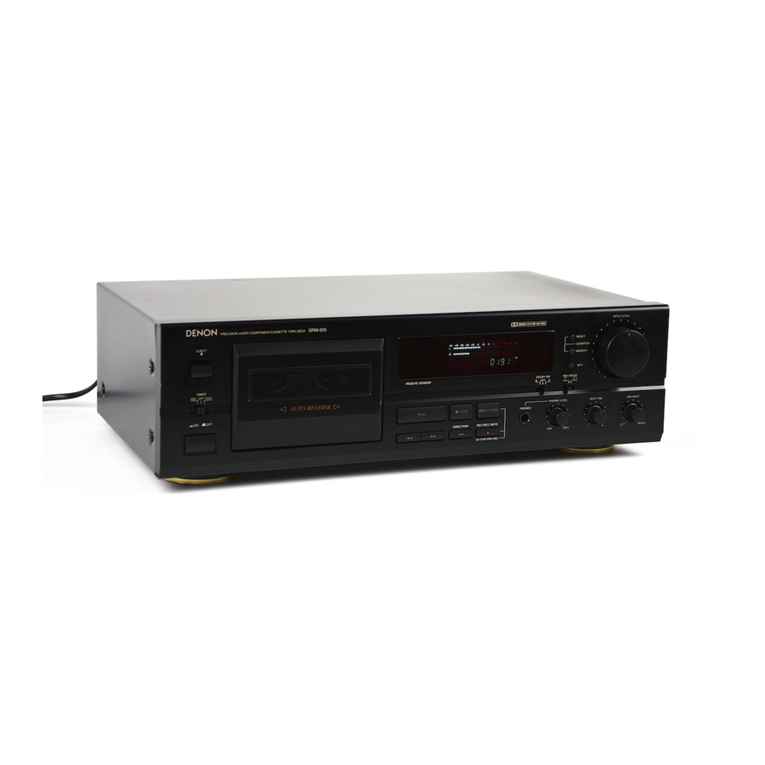
Denon
Denon DRM-555 User manual
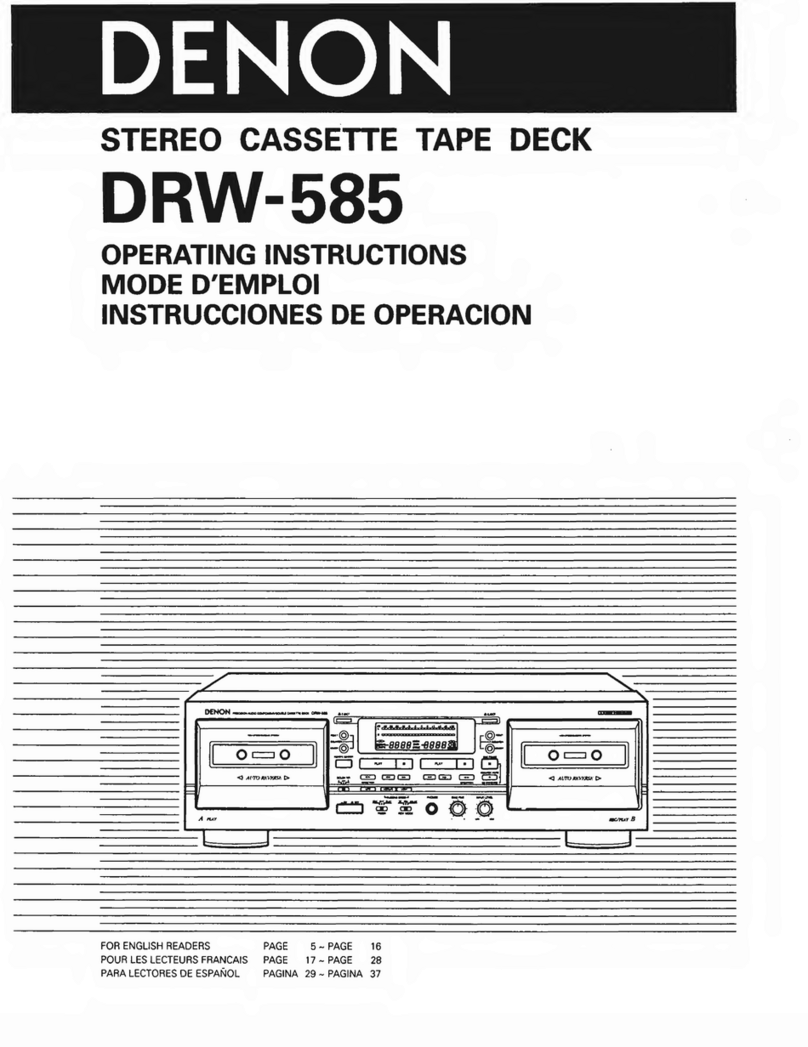
Denon
Denon DRW-585 User manual
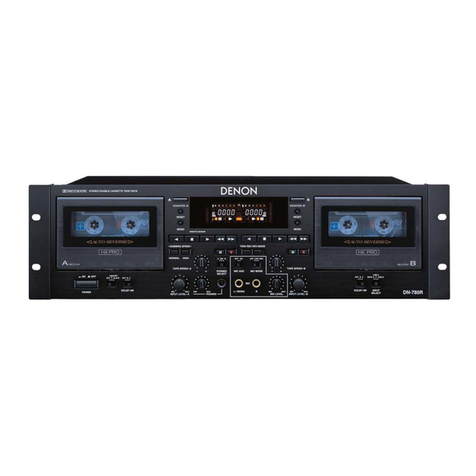
Denon
Denon DN-780R User manual
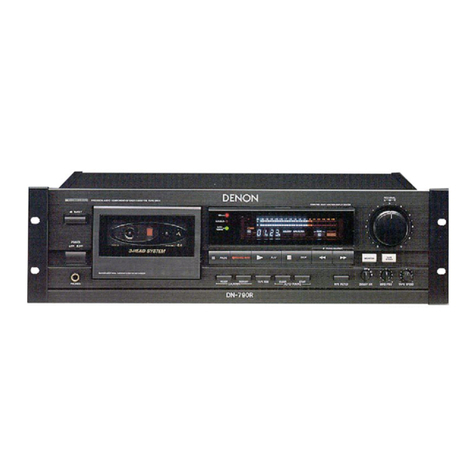
Denon
Denon DN-790R User manual

Denon
Denon DRW-695 User manual
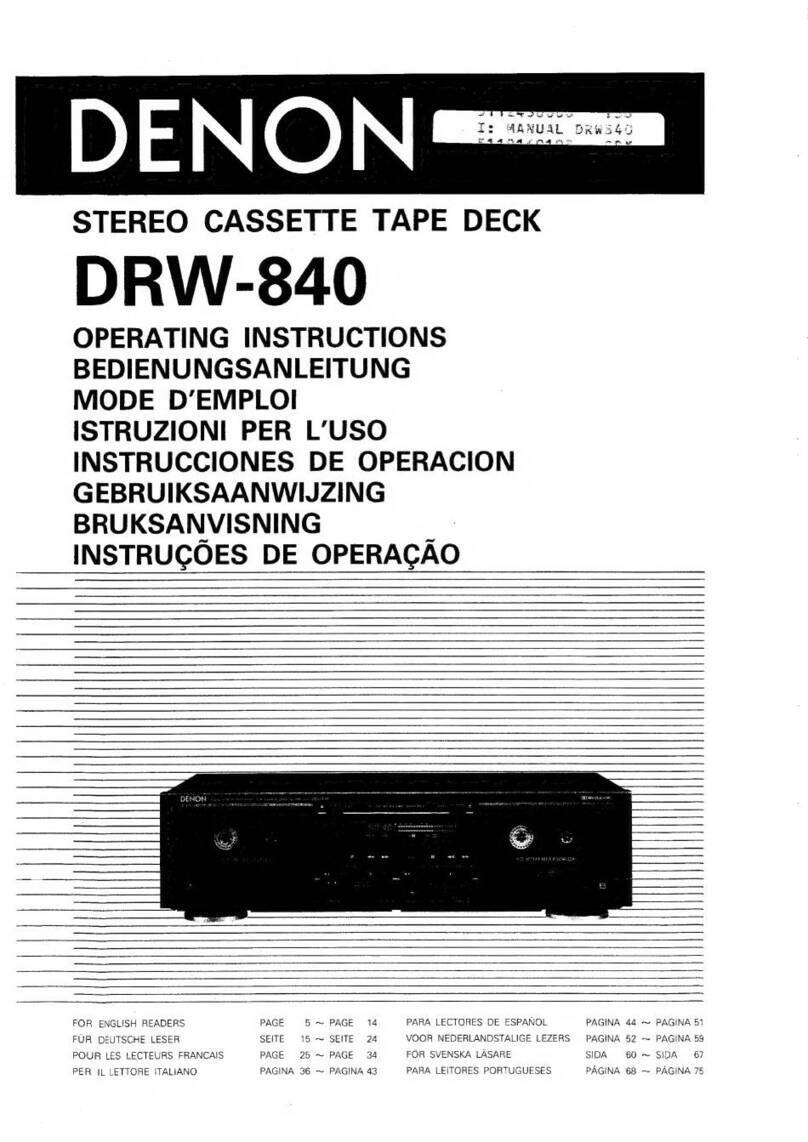
Denon
Denon DRW840 - Stereo Double Cassette Deck User manual
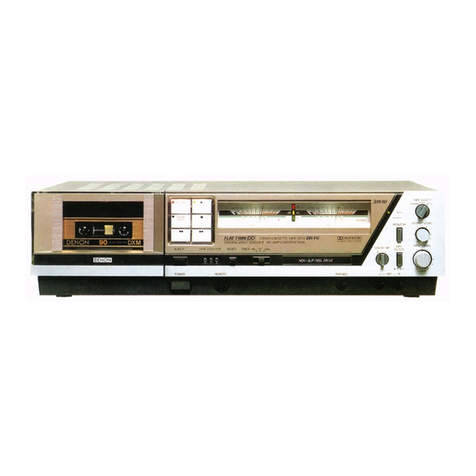
Denon
Denon DR-F6 User manual
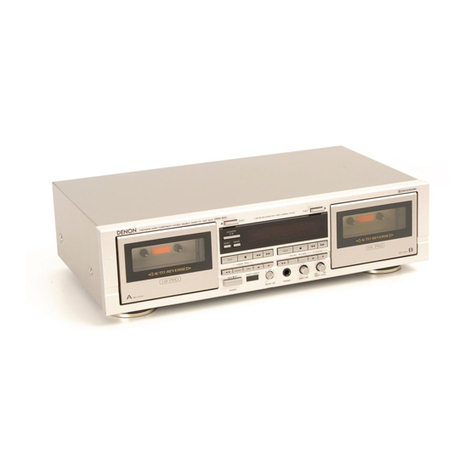
Denon
Denon DRW840 - Stereo Double Cassette Deck User manual

Denon
Denon DN-780R User manual

Denon
Denon DRW-585 User manual
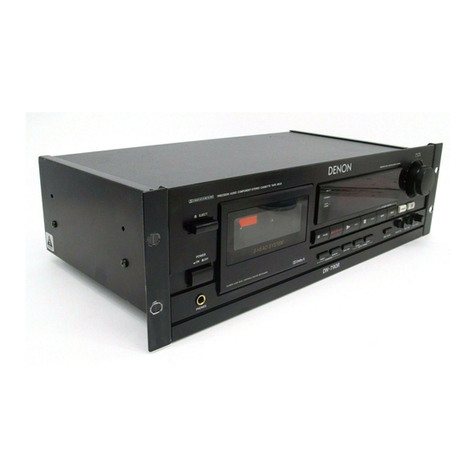
Denon
Denon DN-720R User manual
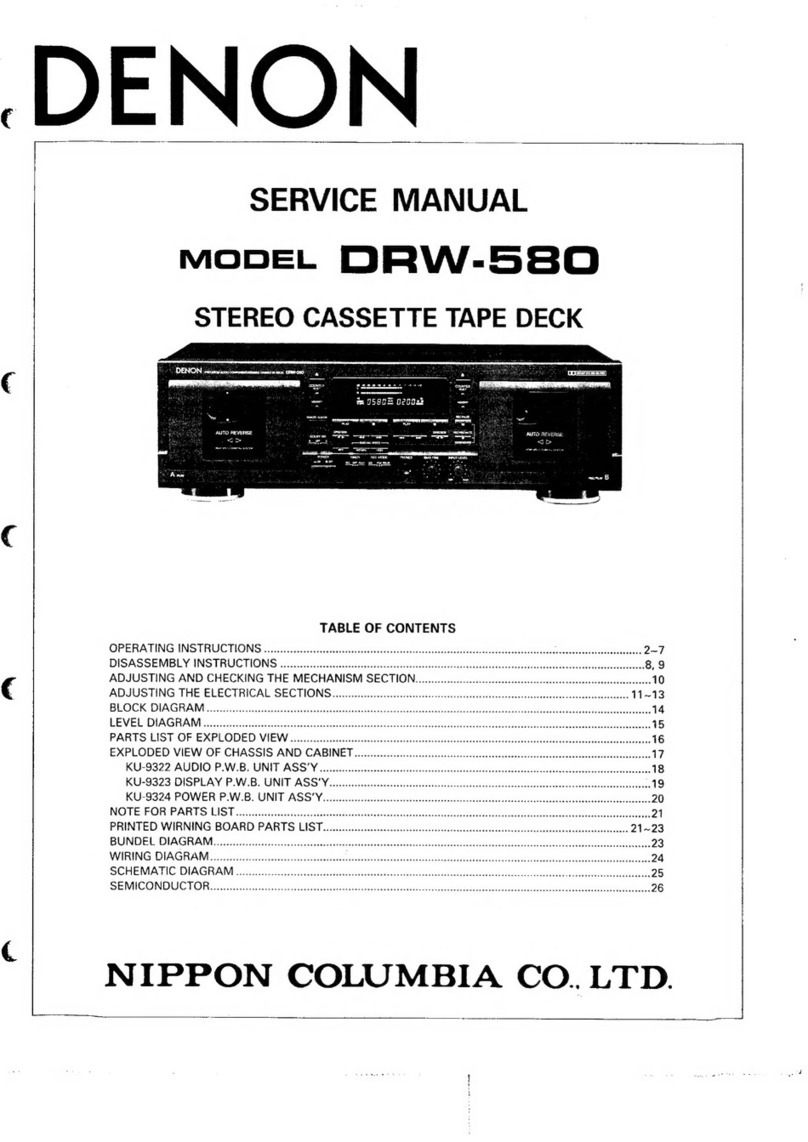
Denon
Denon DRW-5830 User manual

Denon
Denon DR-M2 User manual

Denon
Denon DRR-M30 User manual

Denon
Denon DRM-400 User manual

Denon
Denon DN-780R User manual
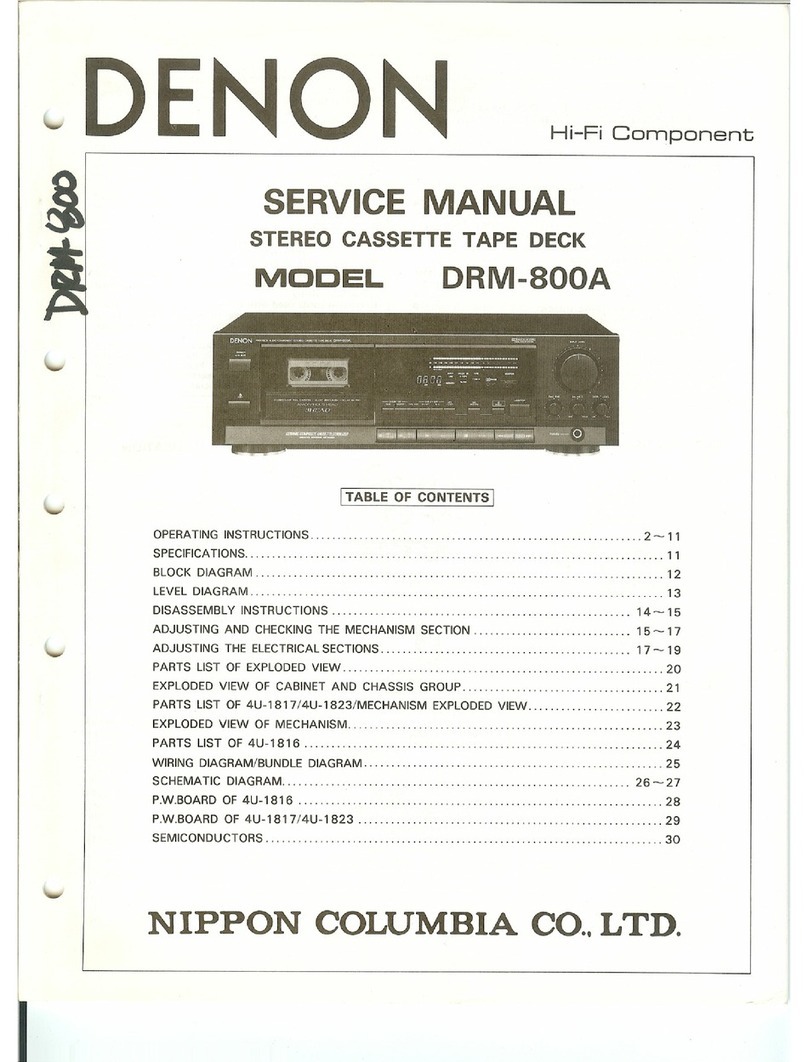
Denon
Denon DRM-800A User manual
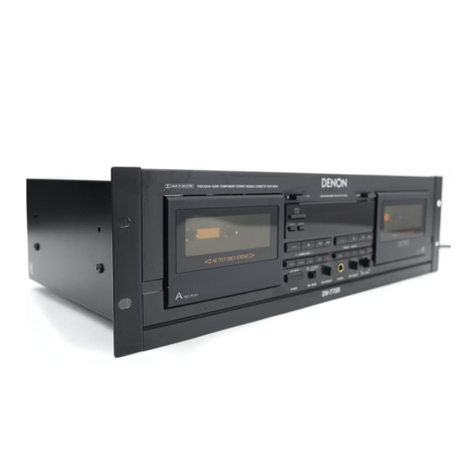
Denon
Denon DN-770R User manual

Denon
Denon DN-730R User manual


